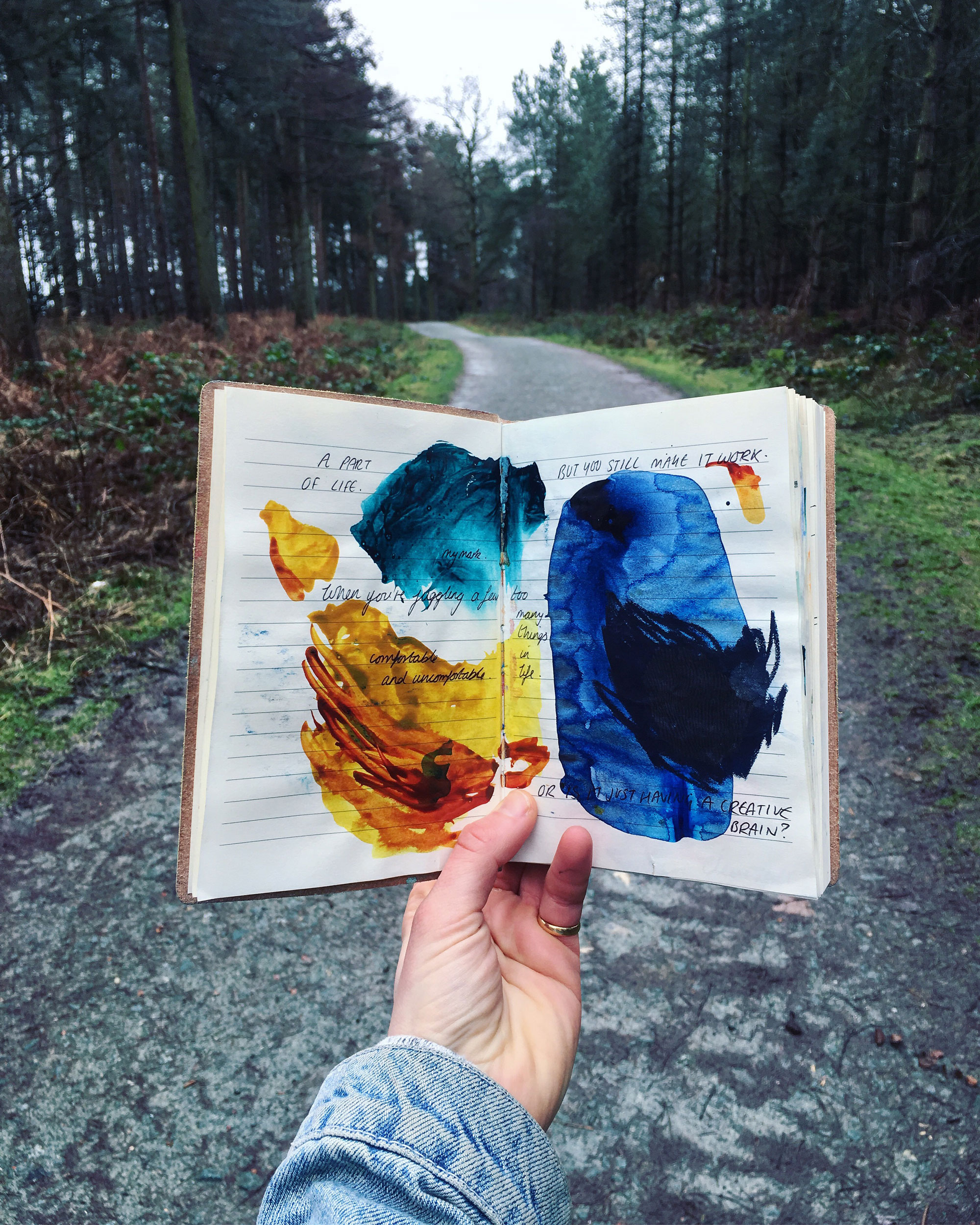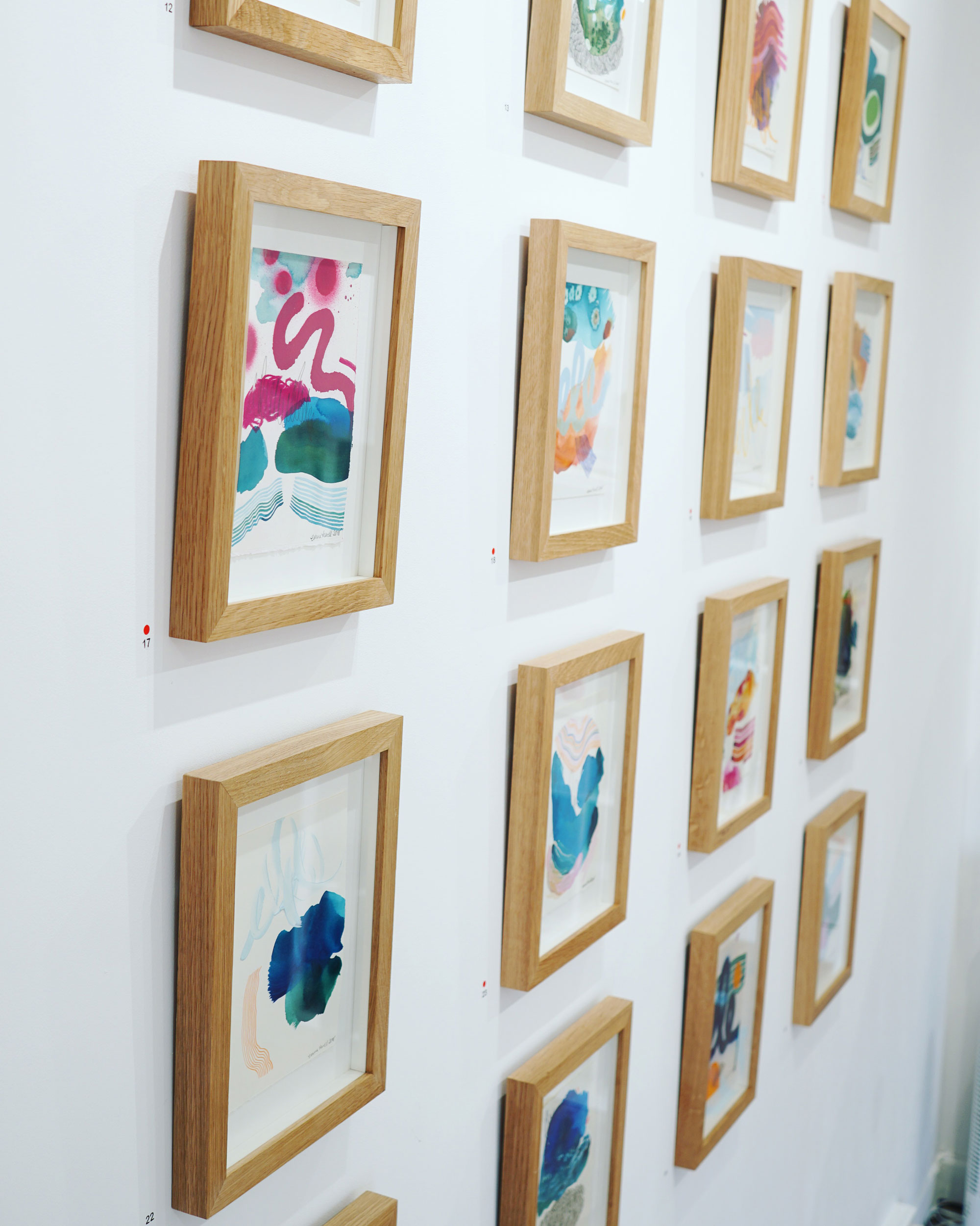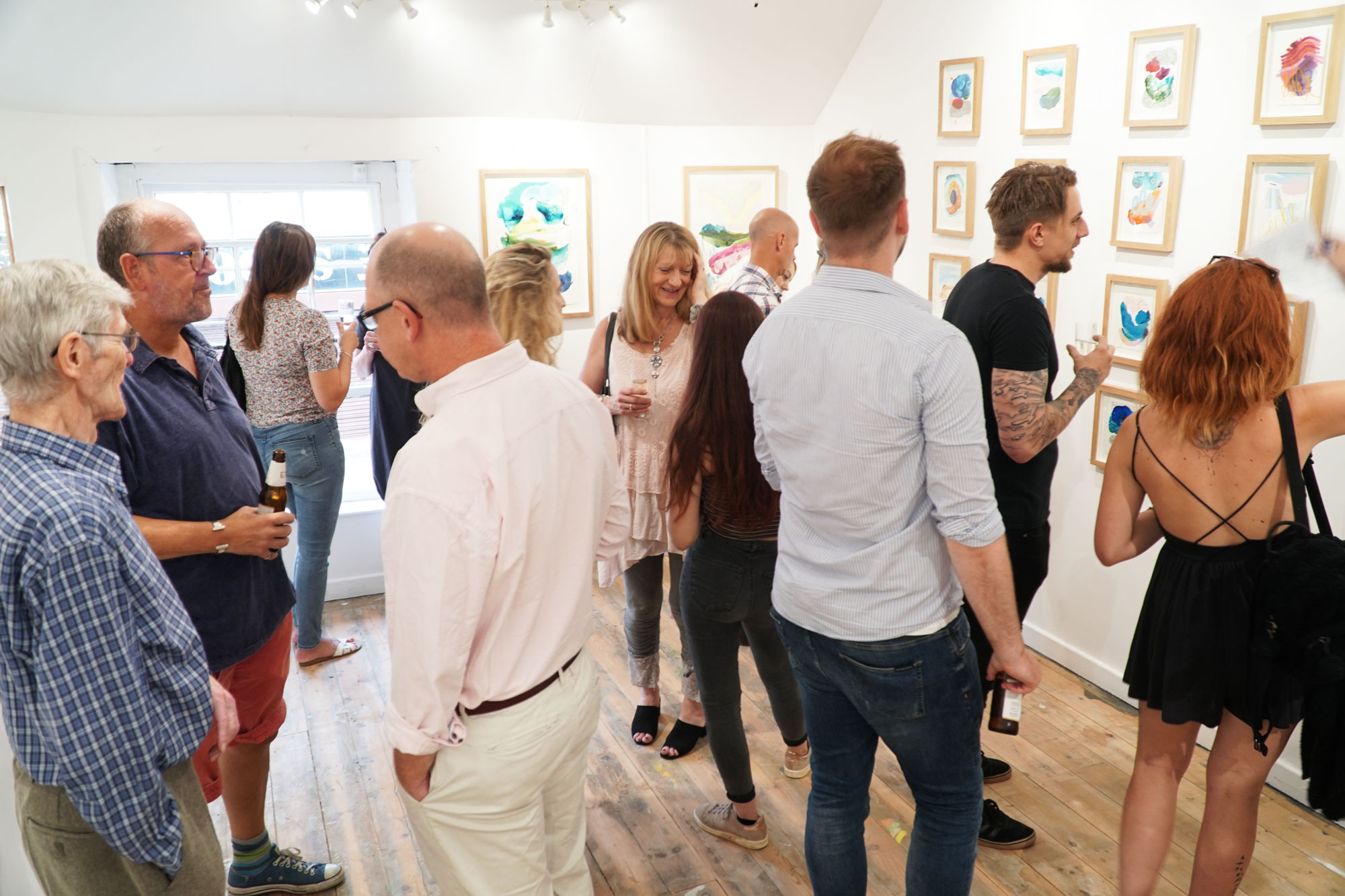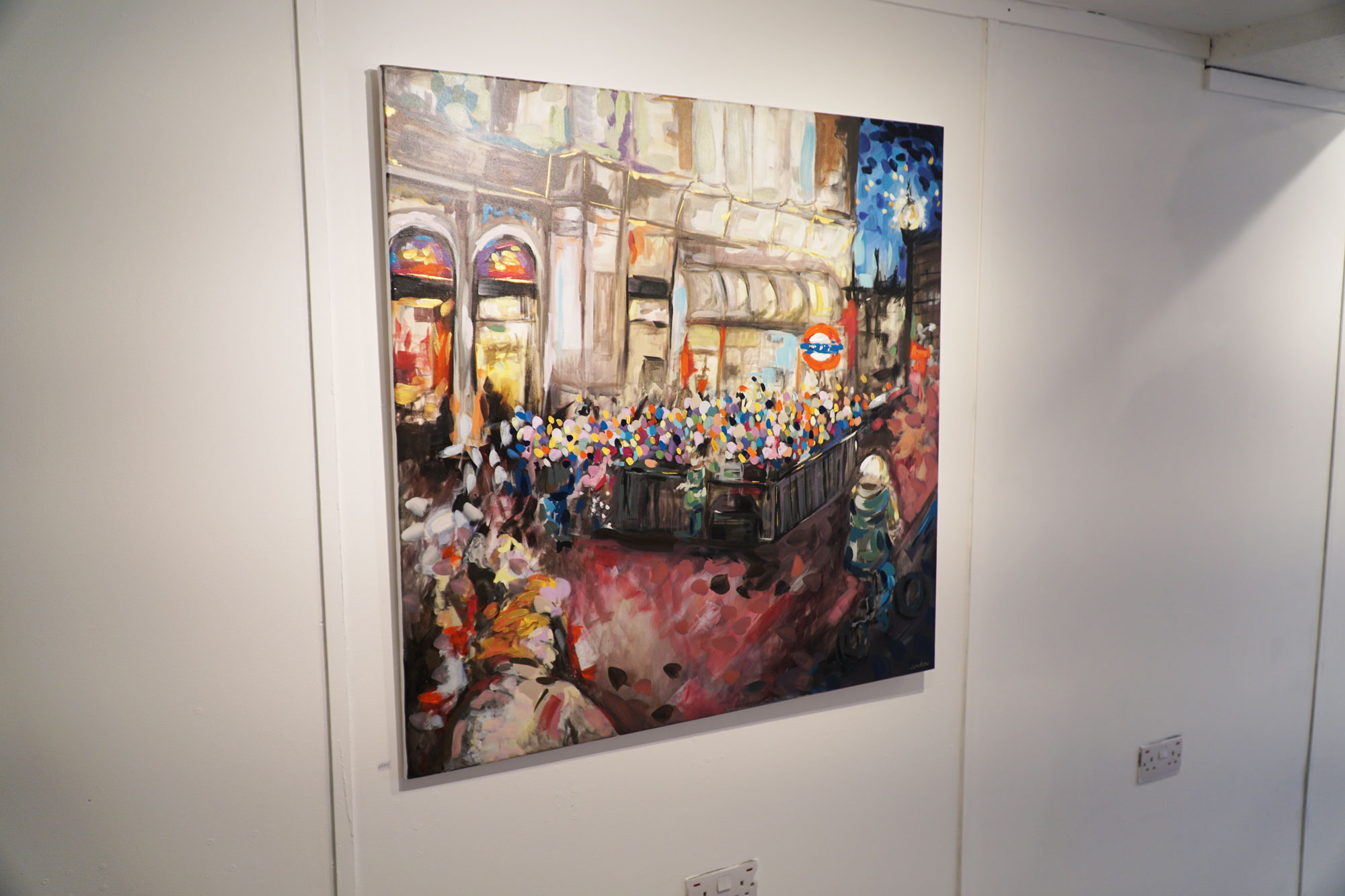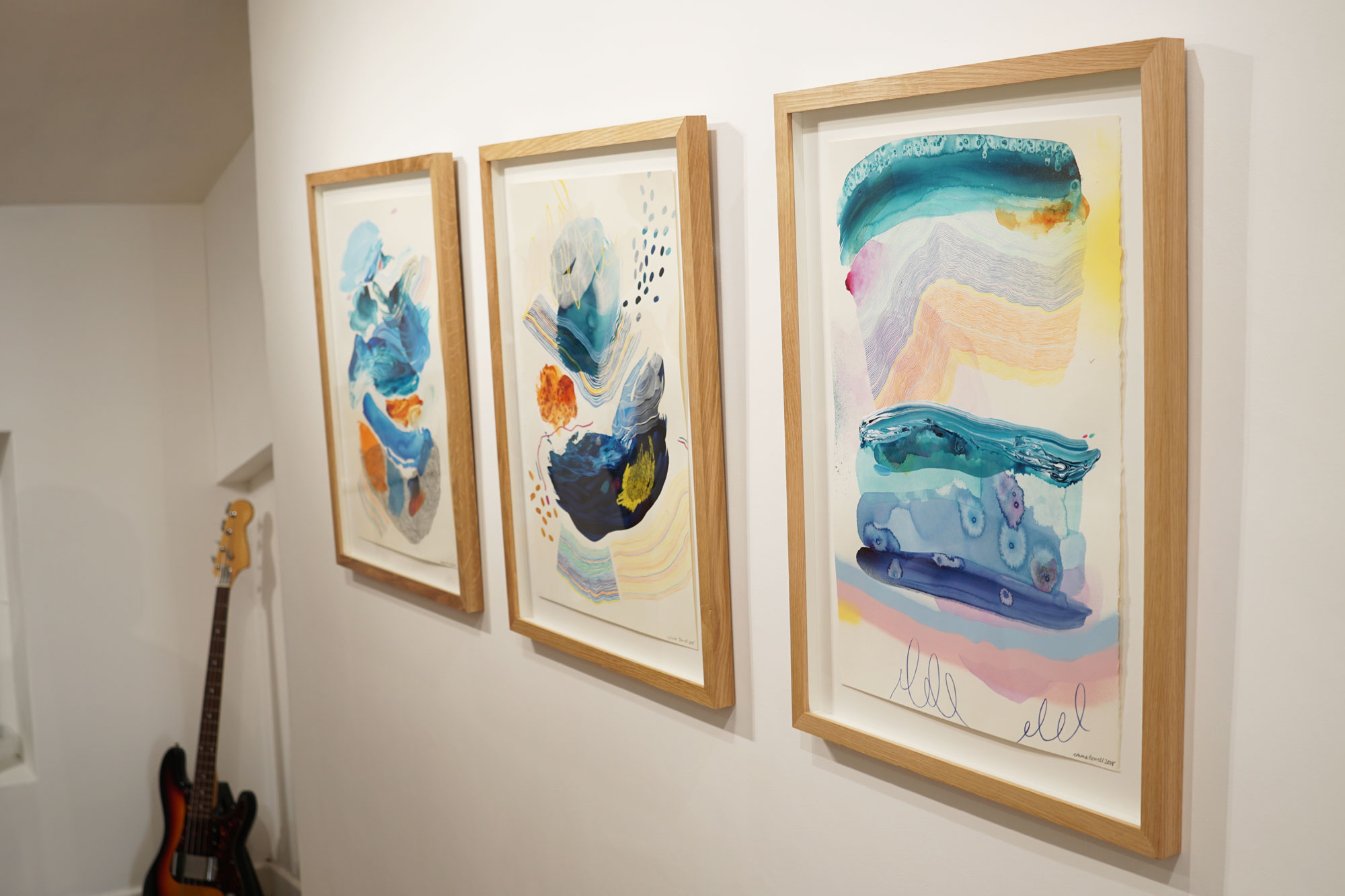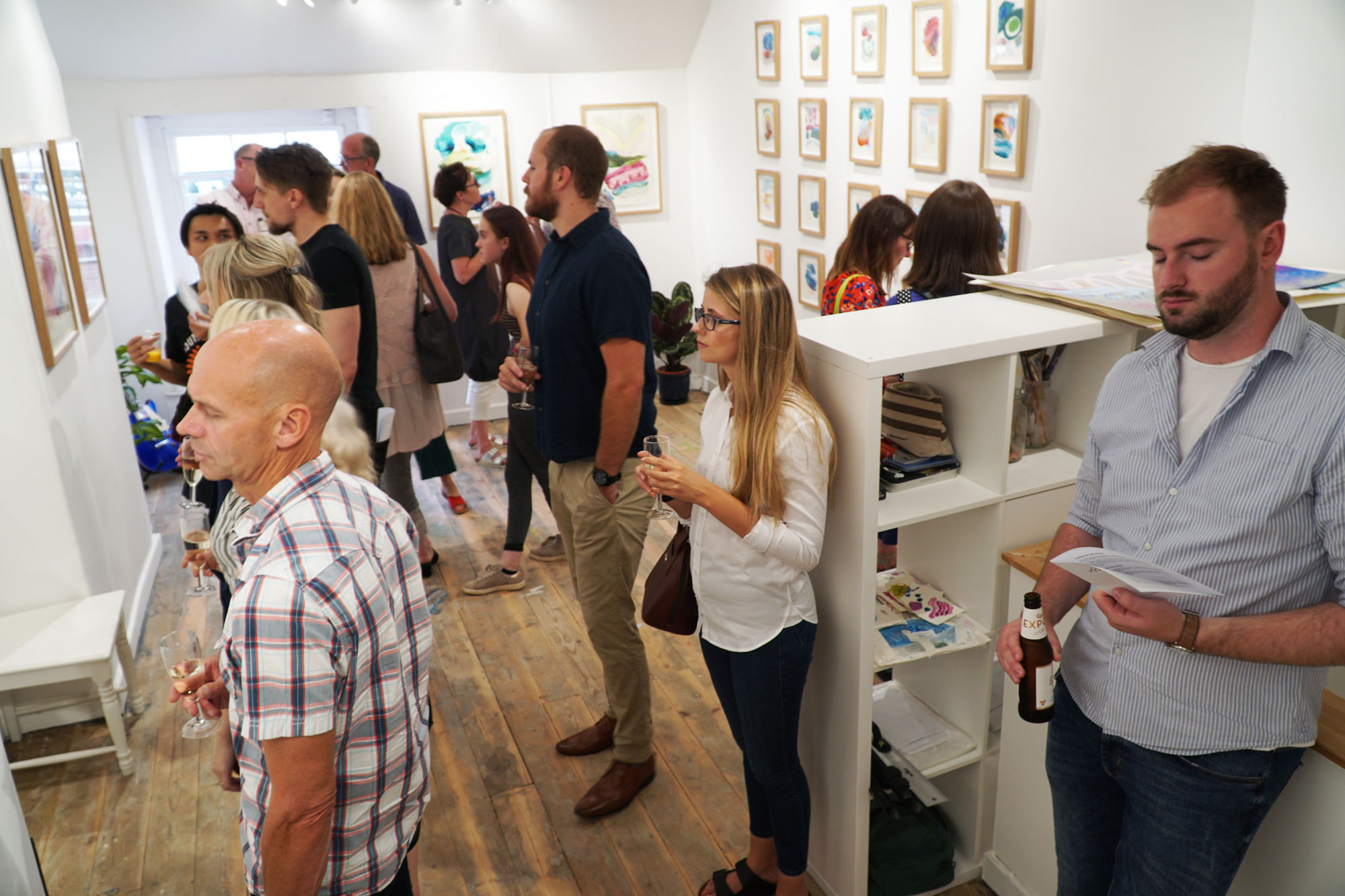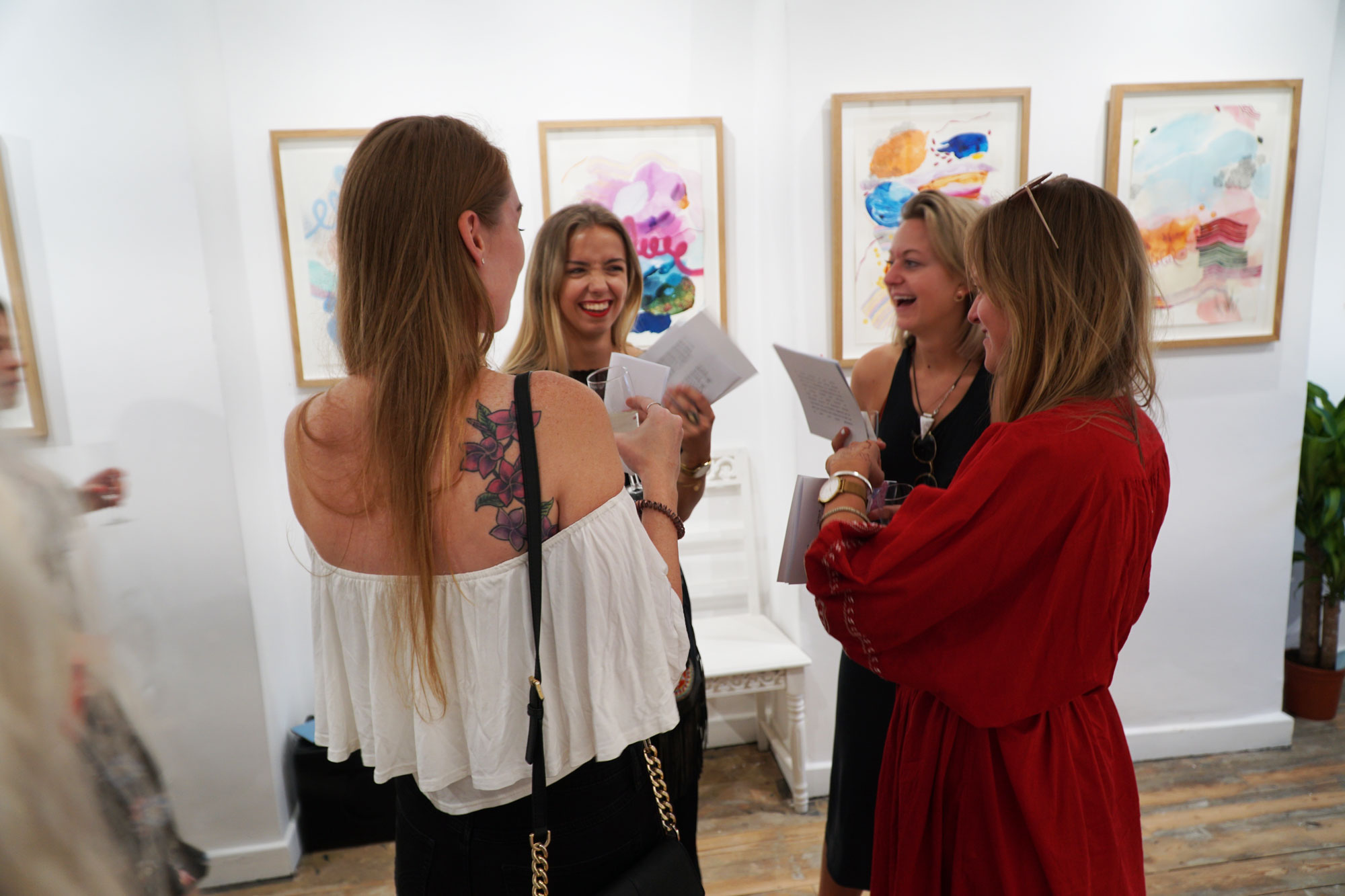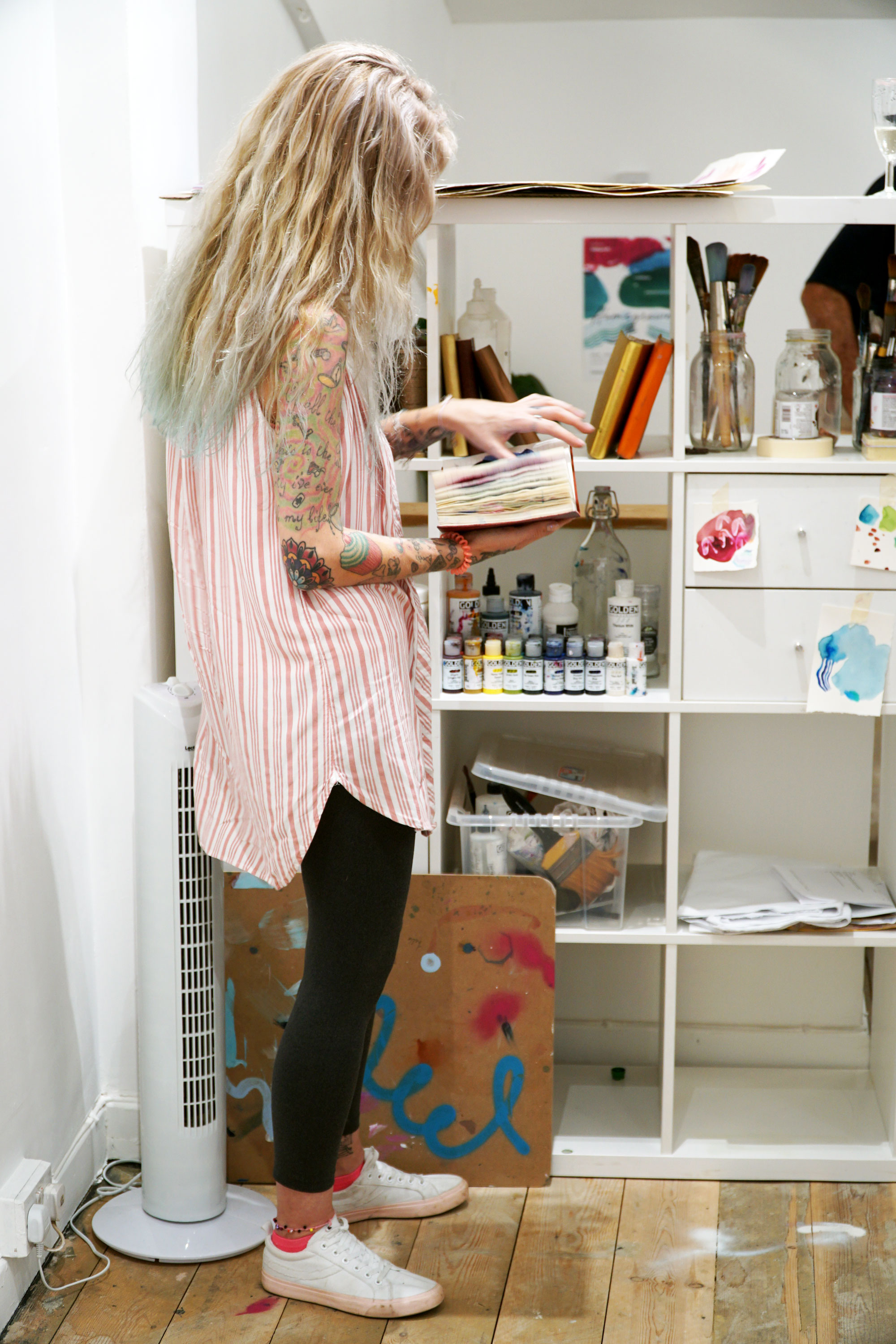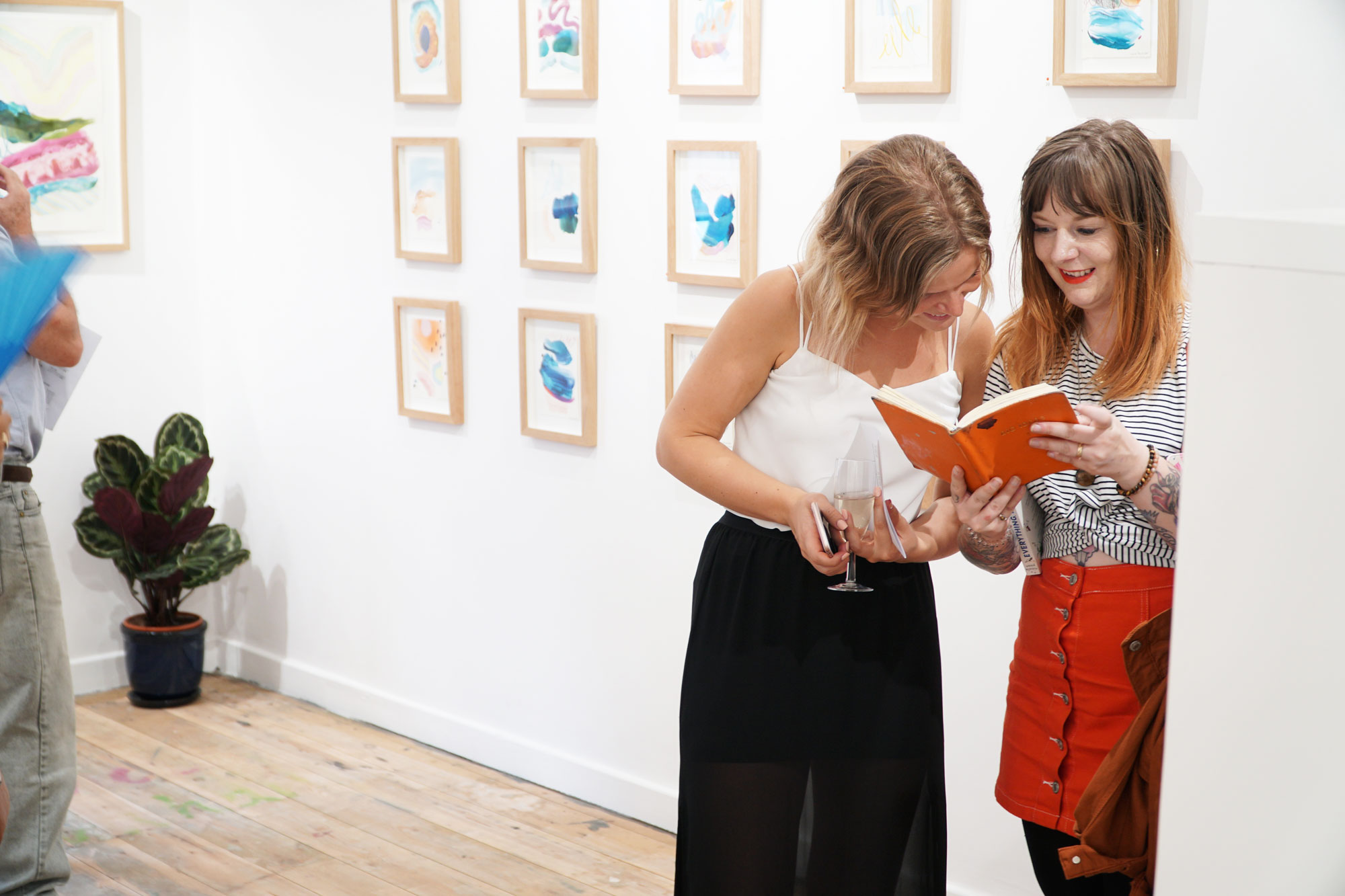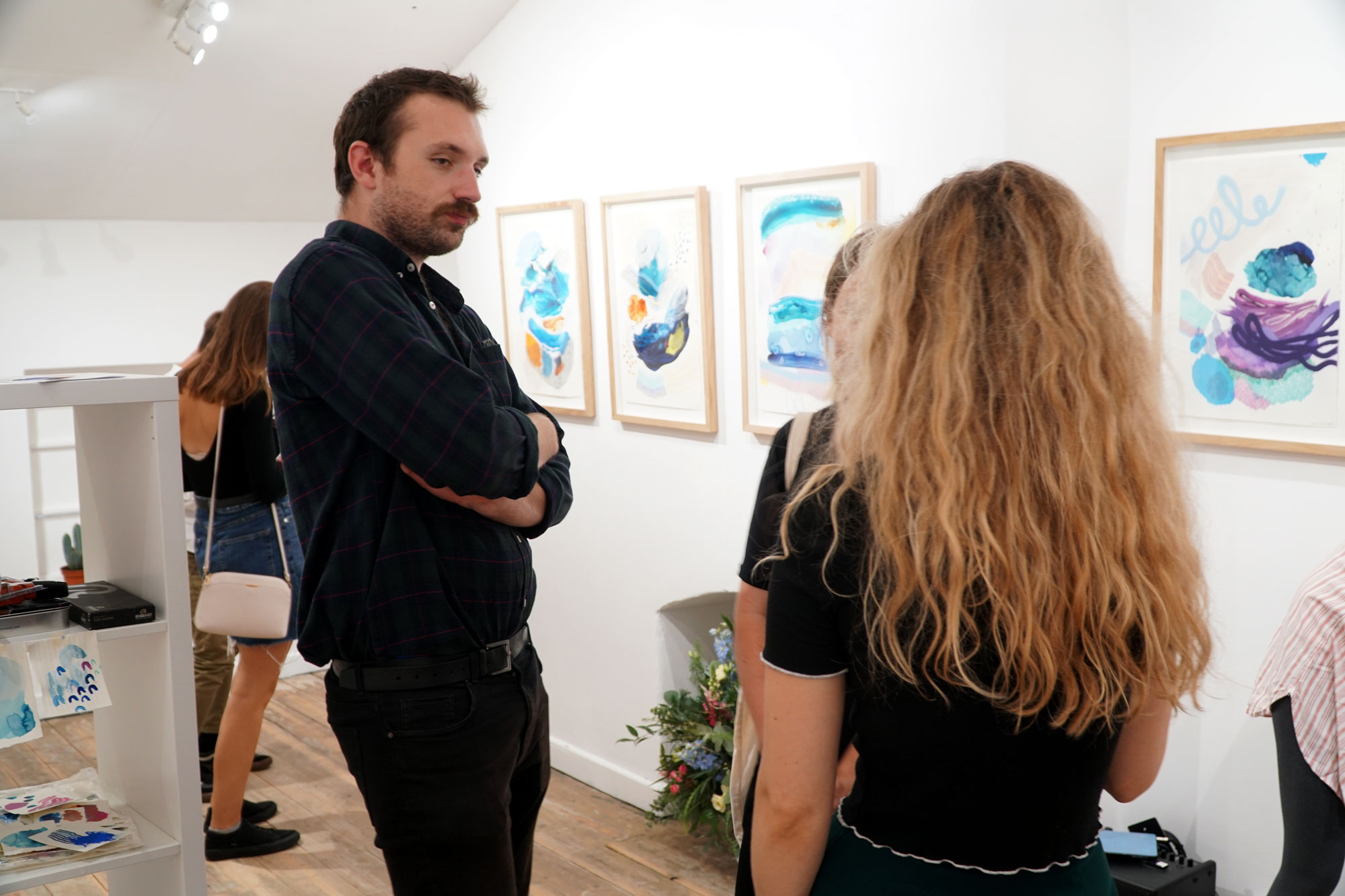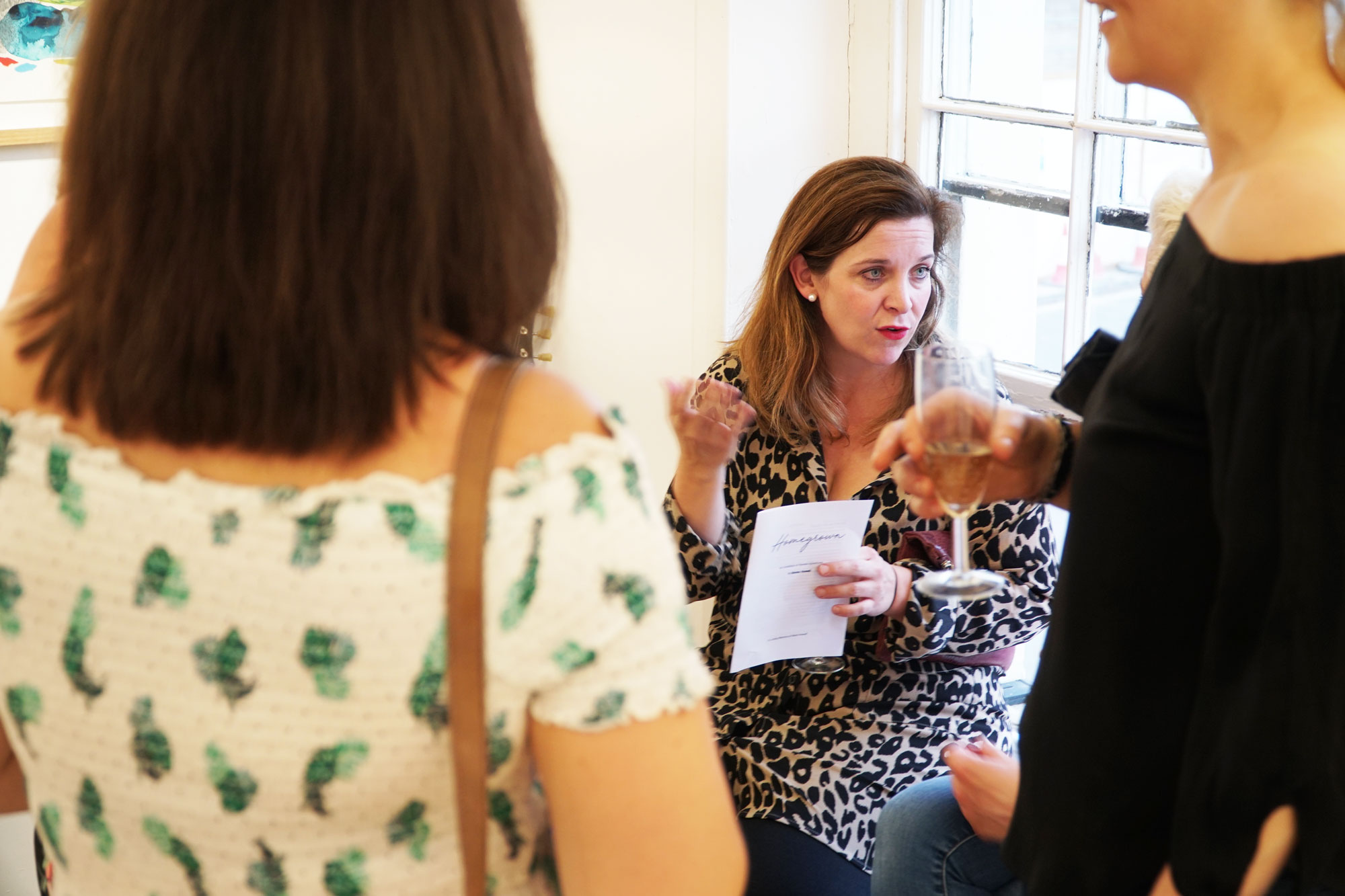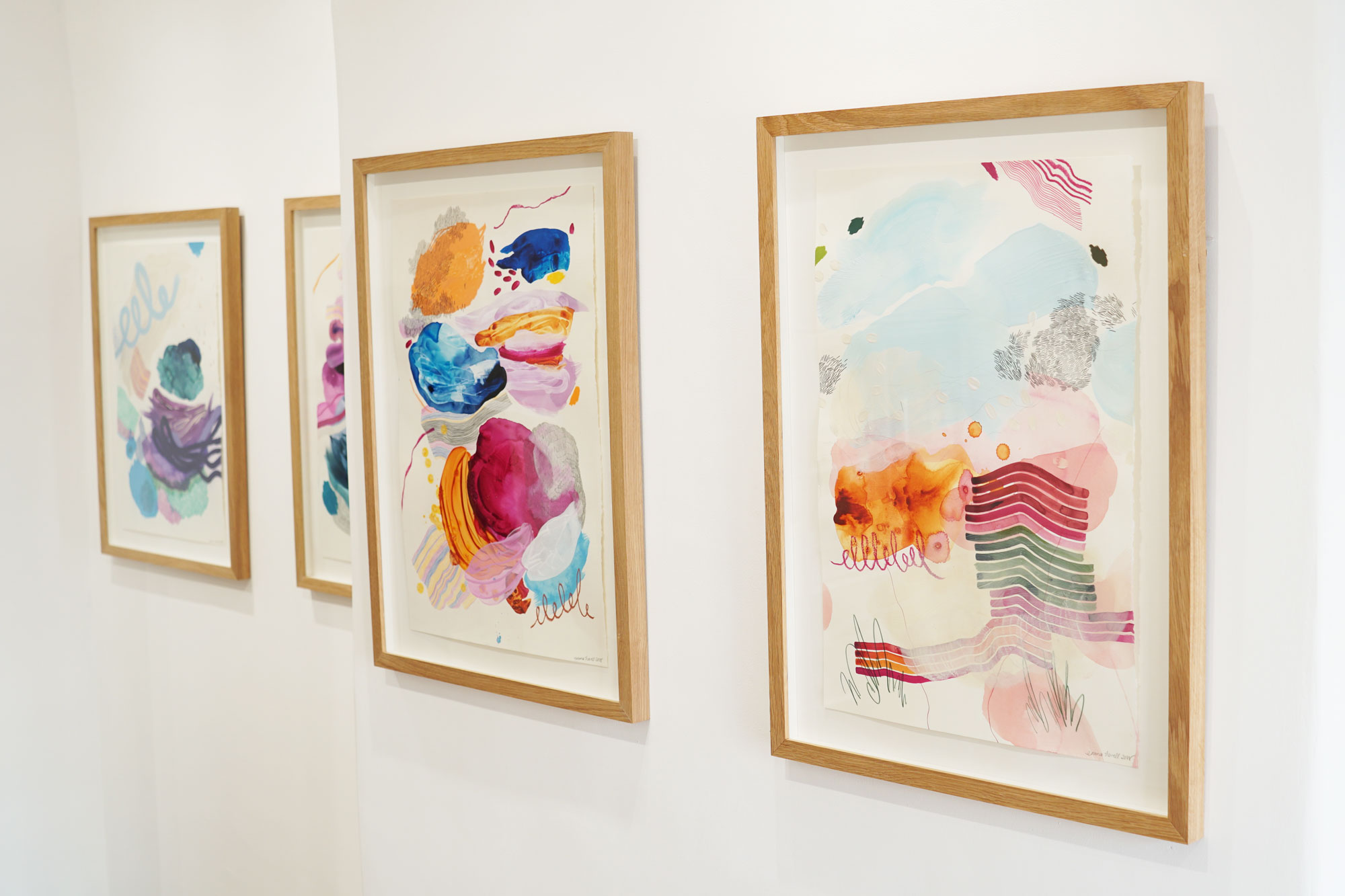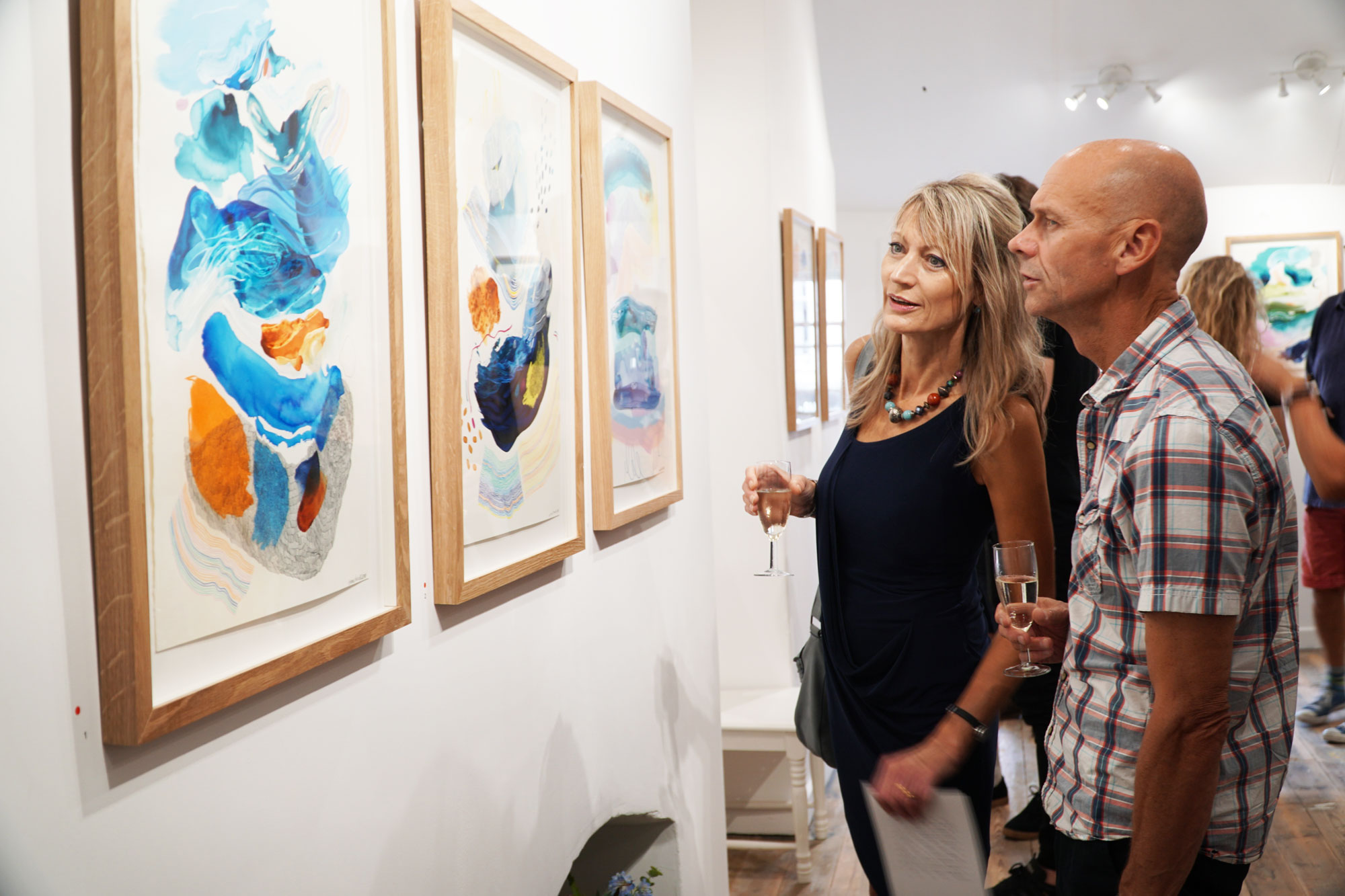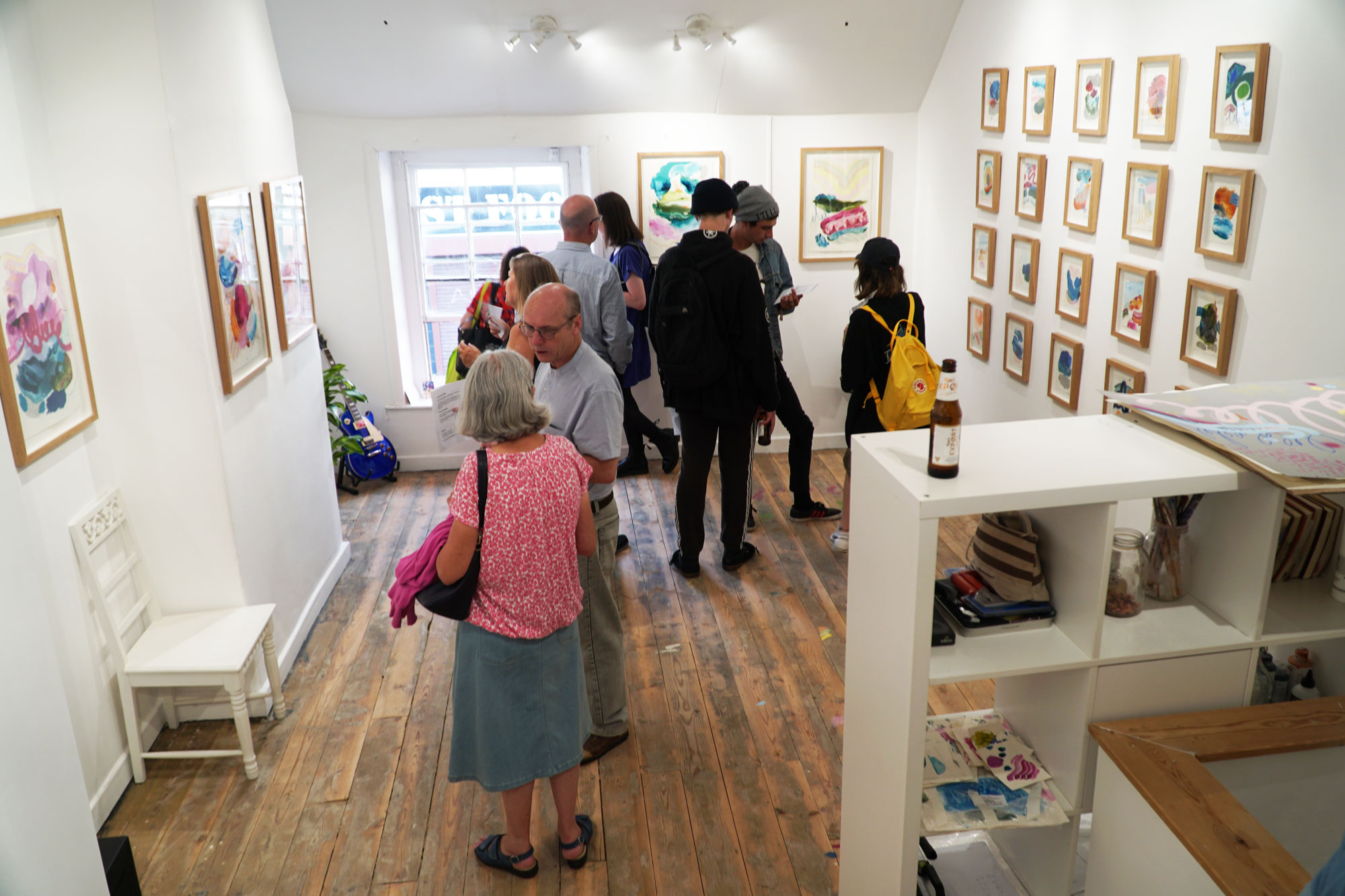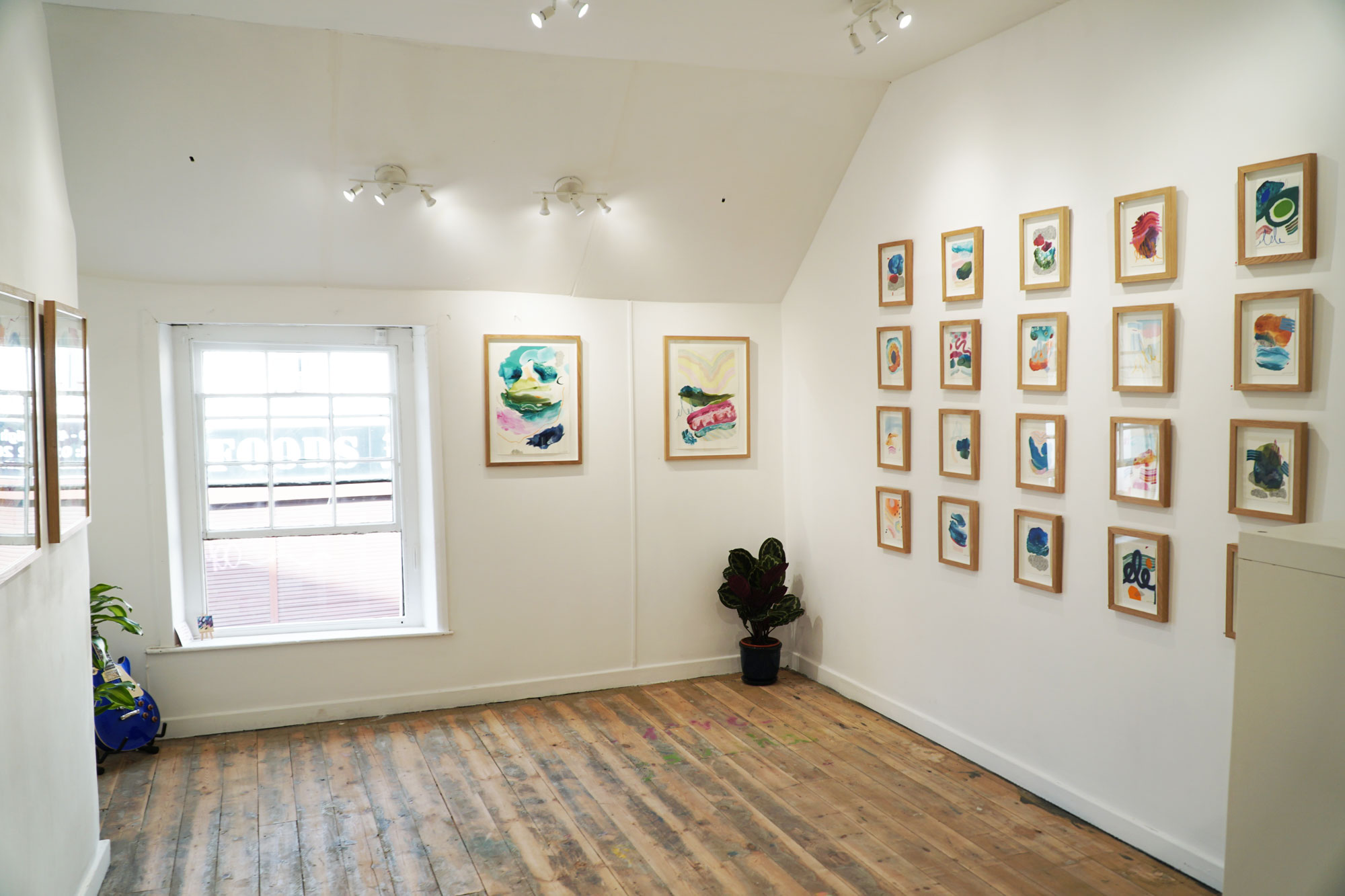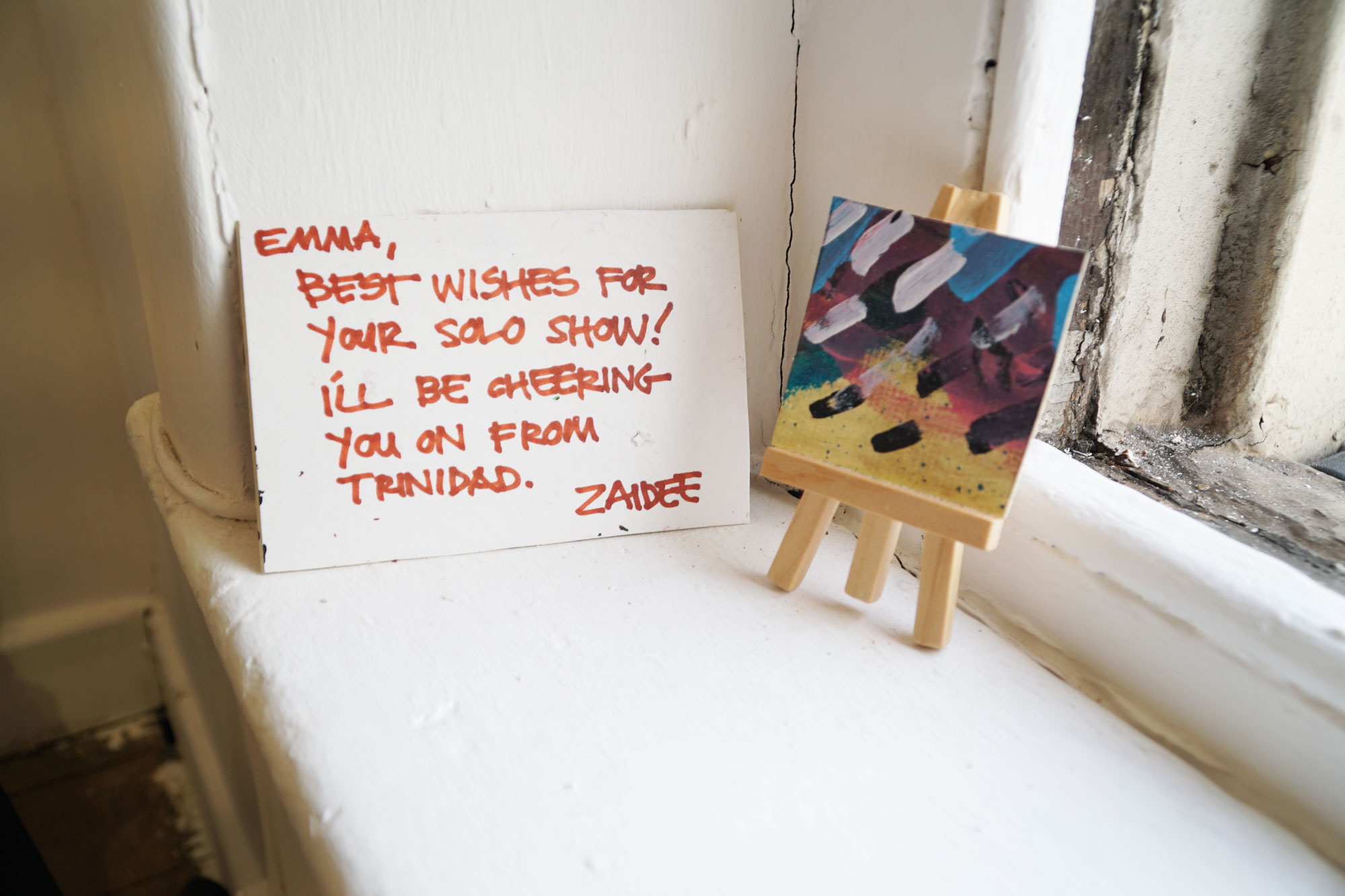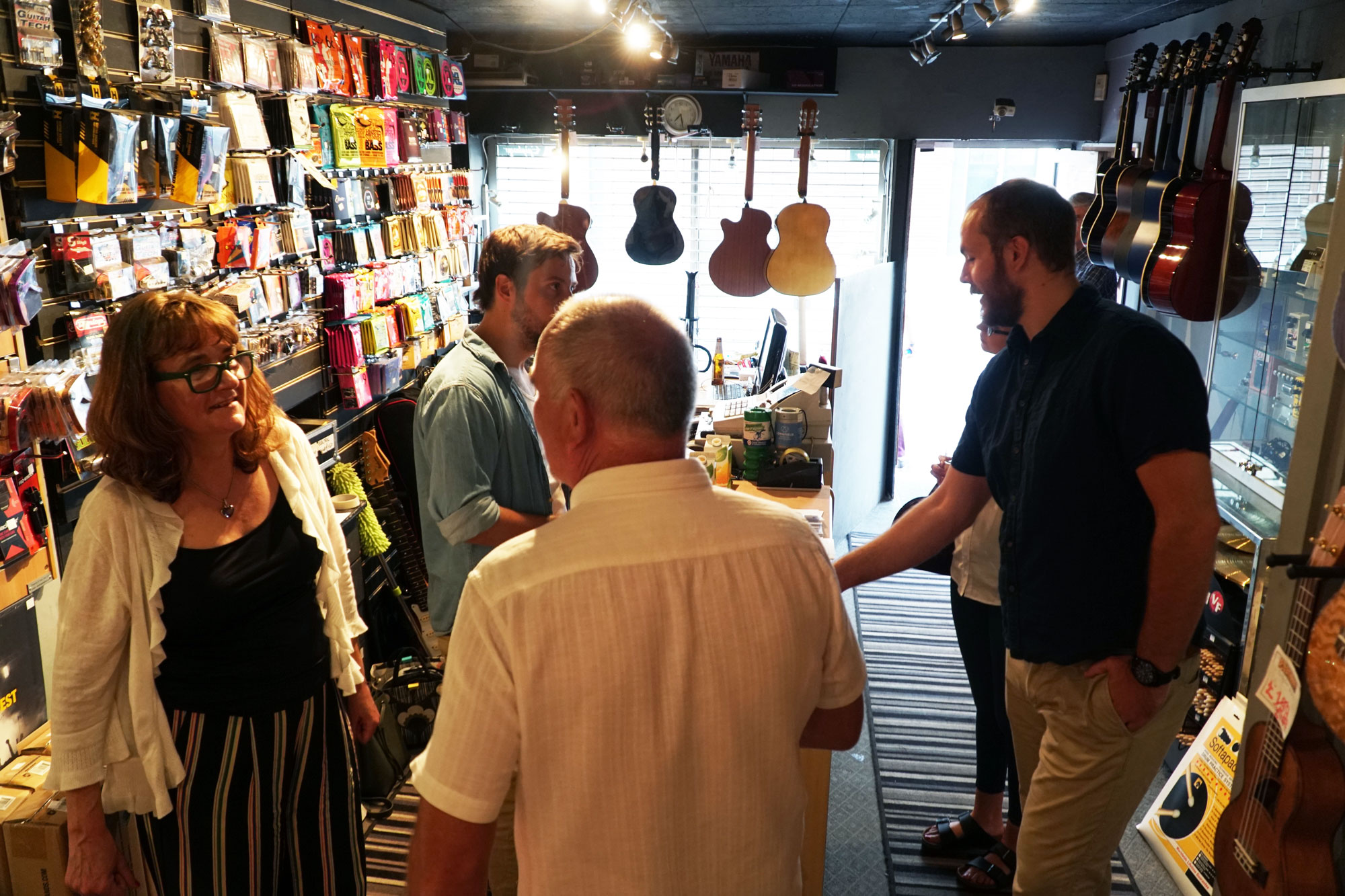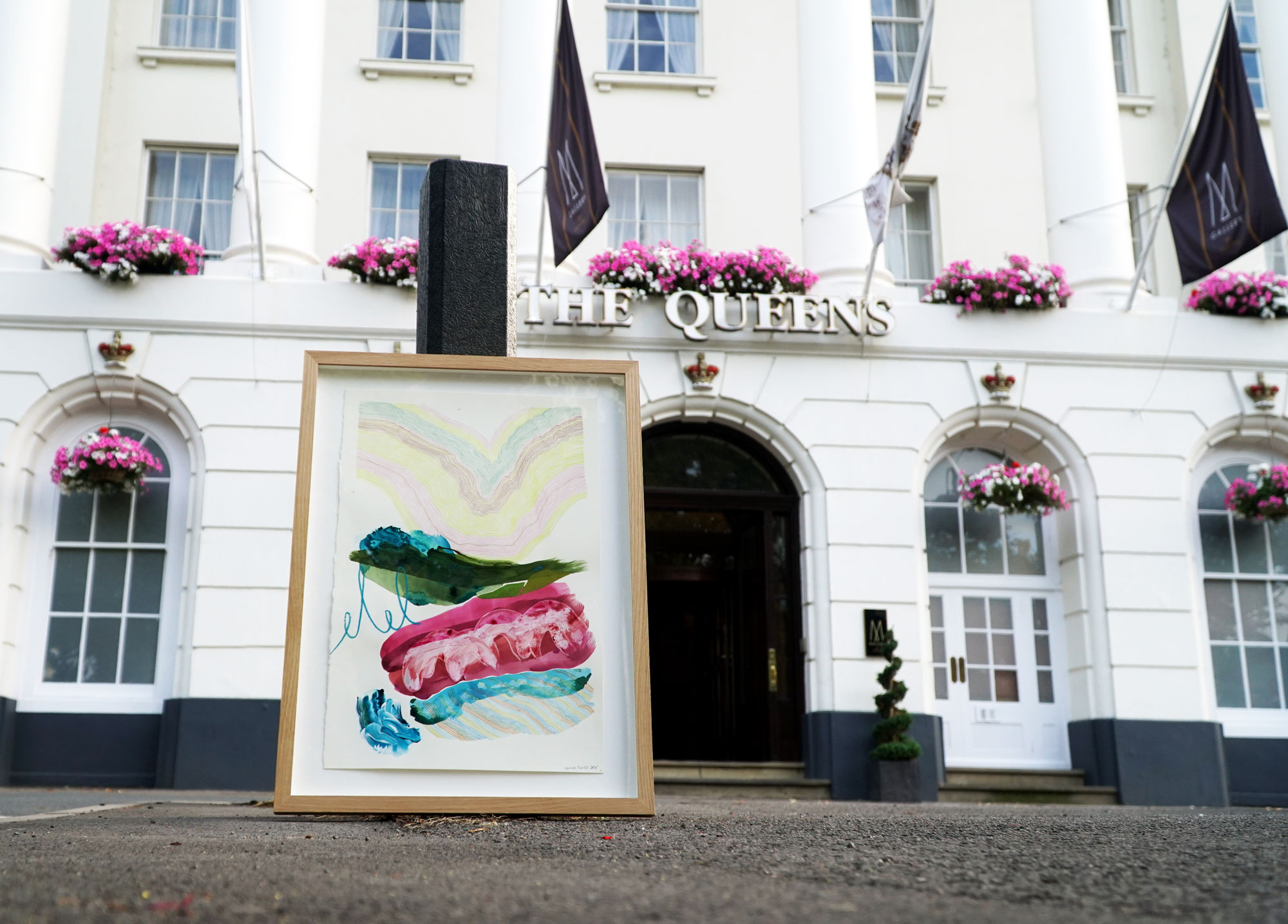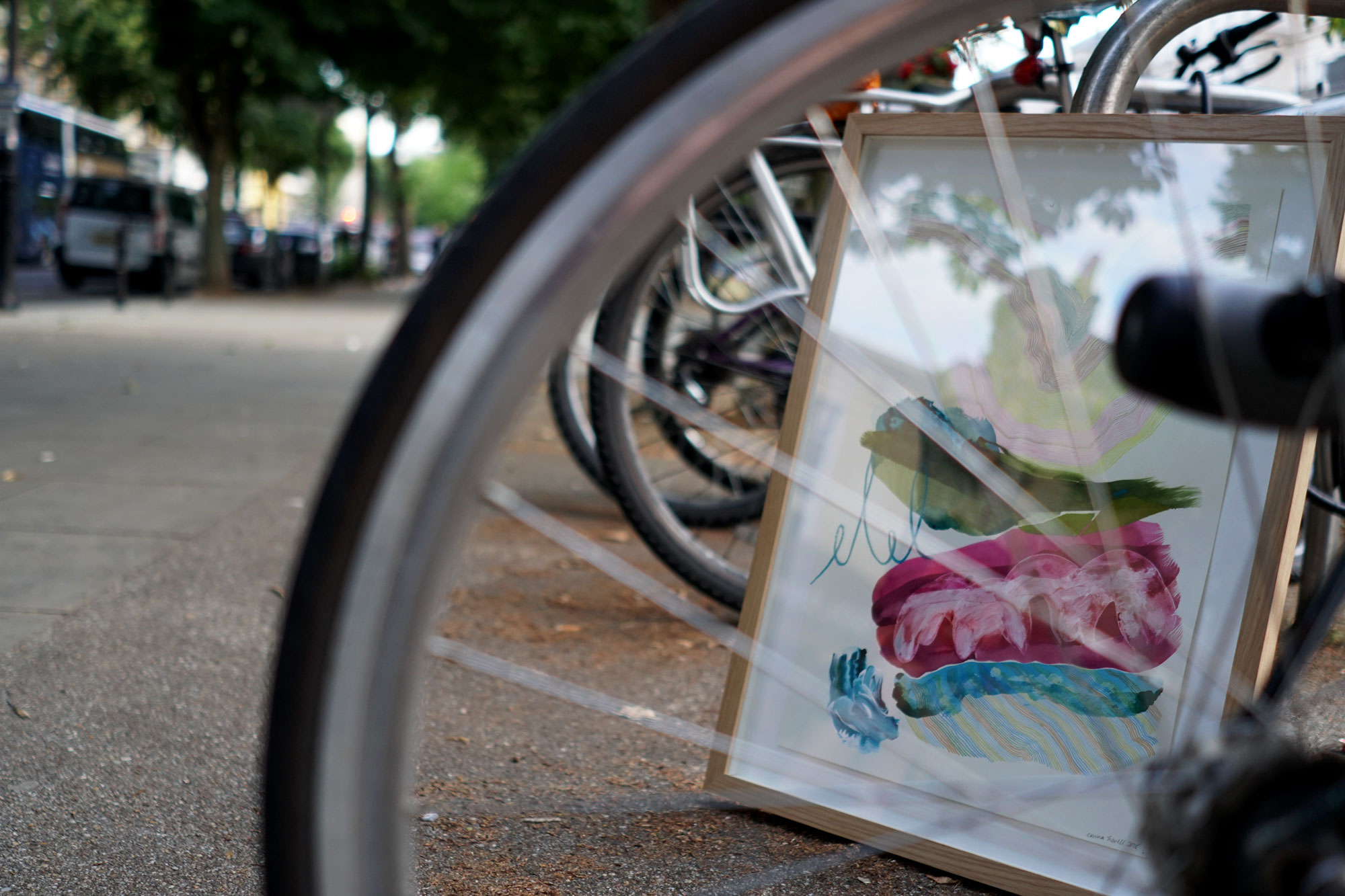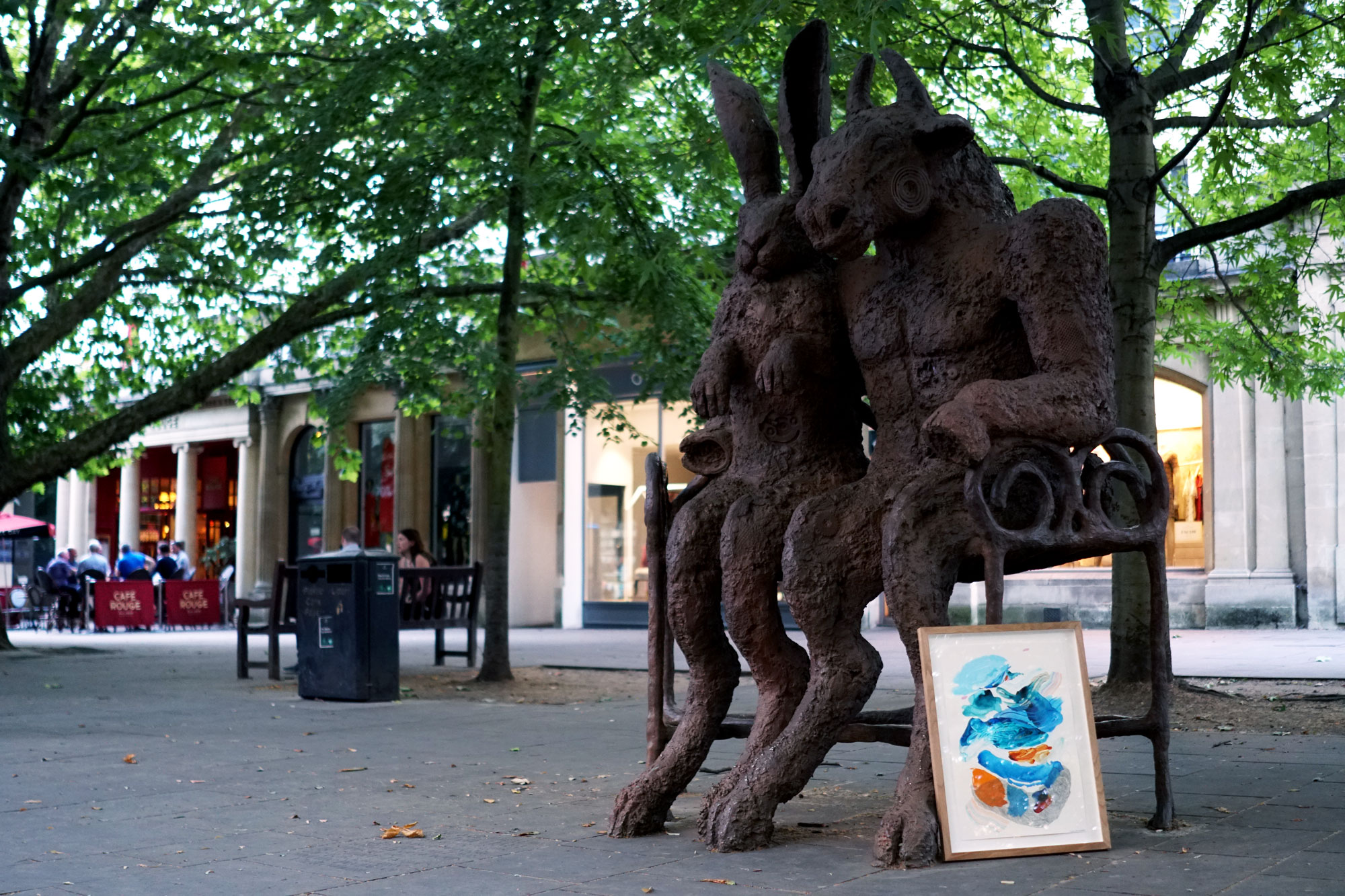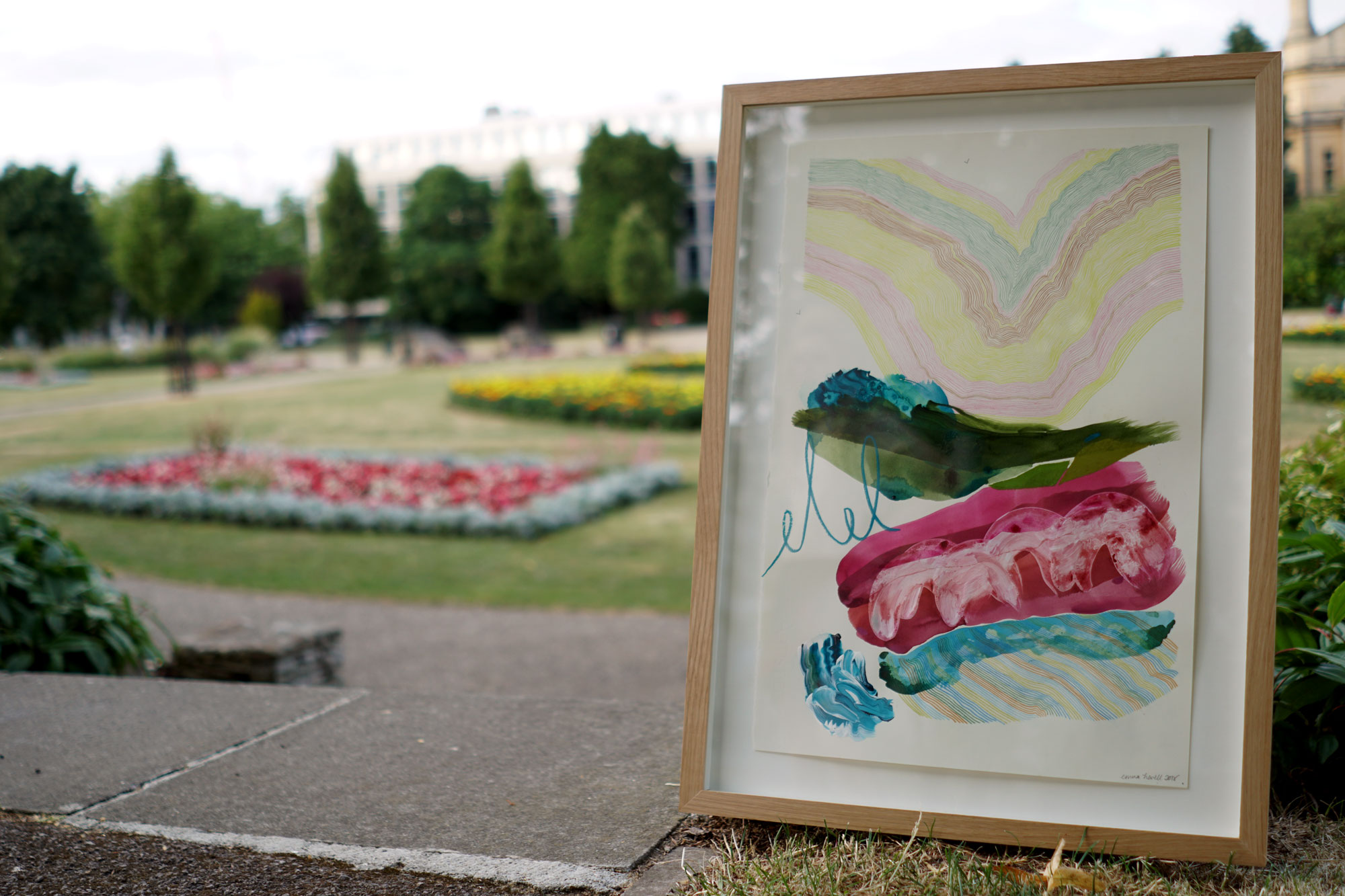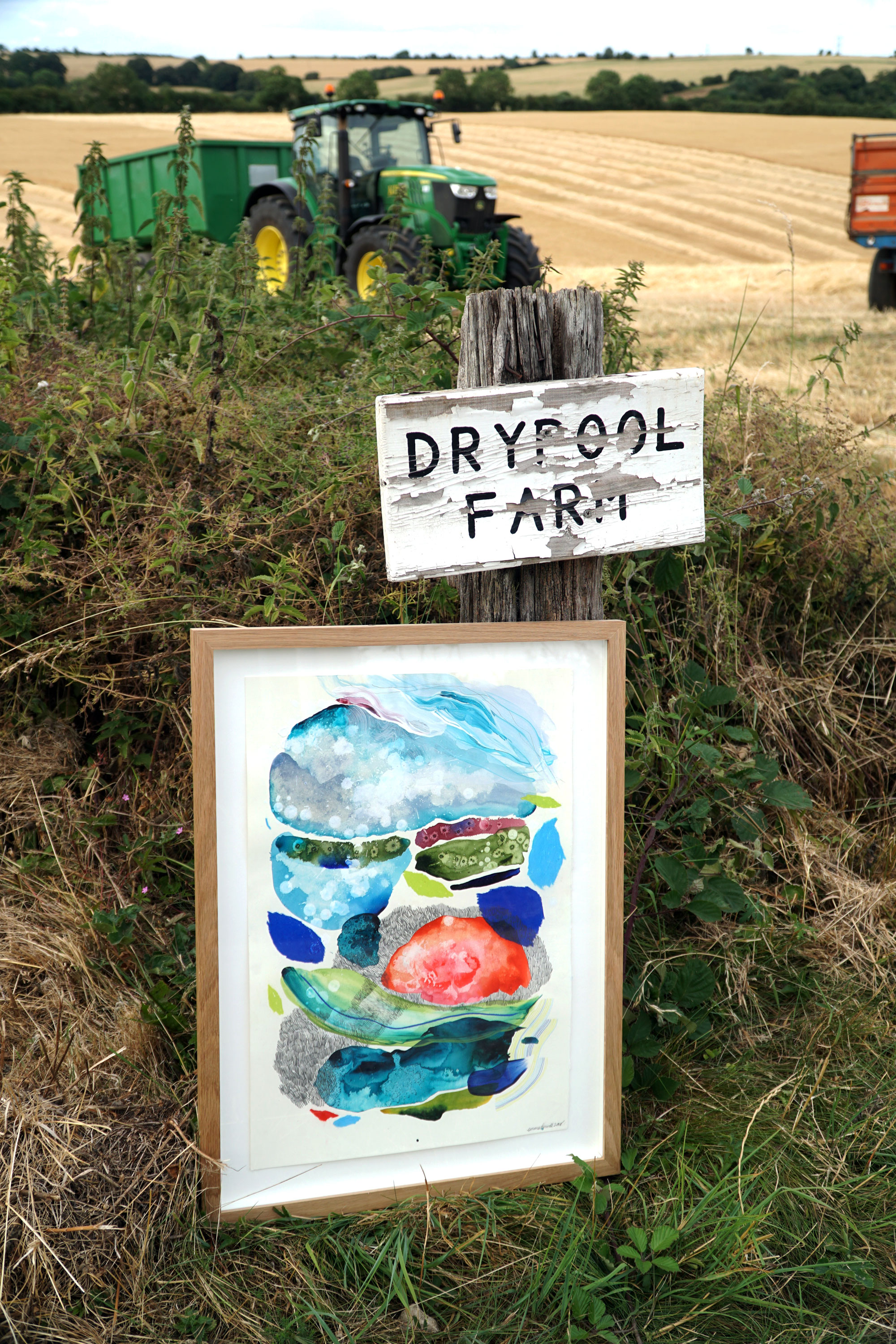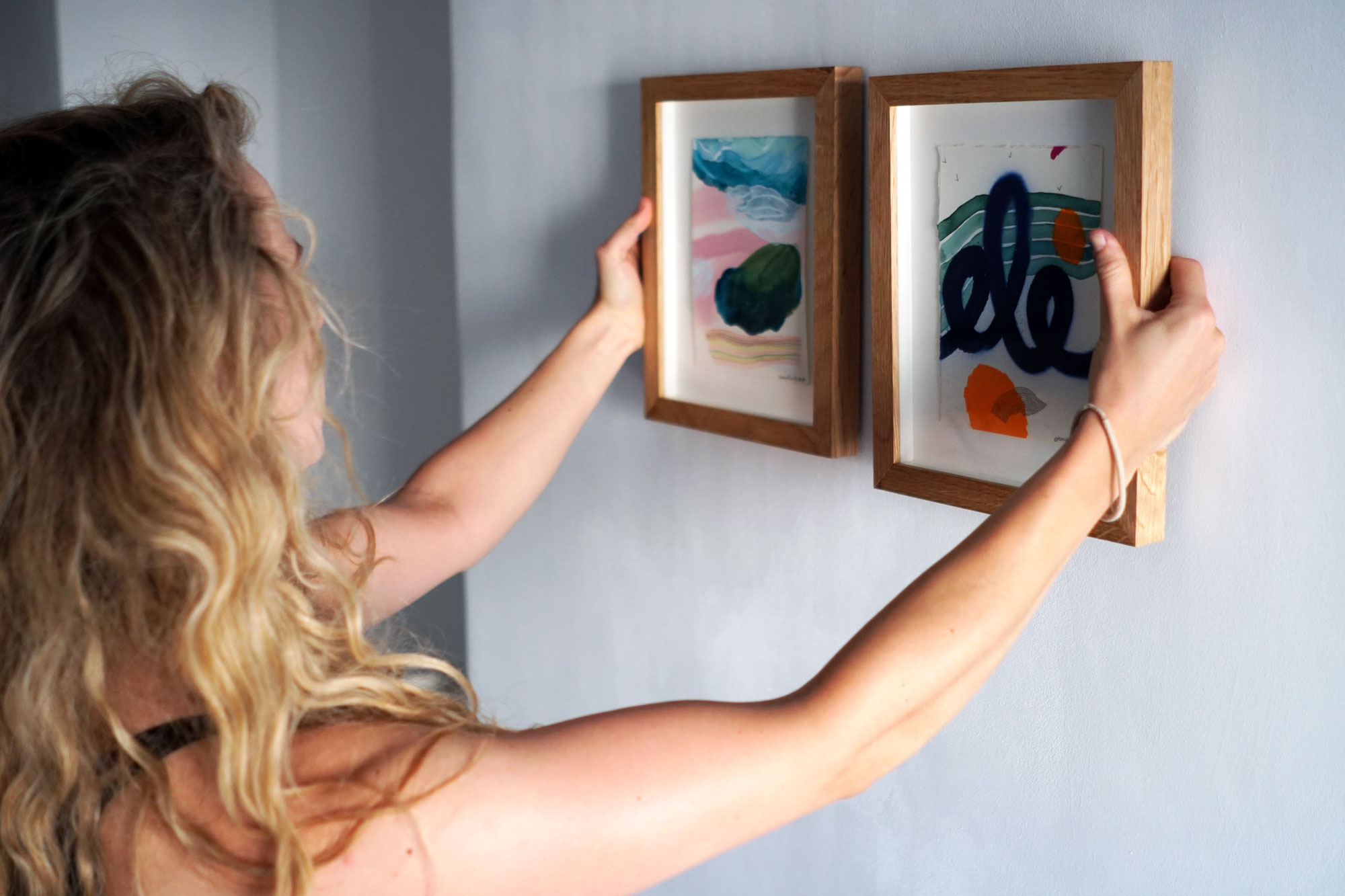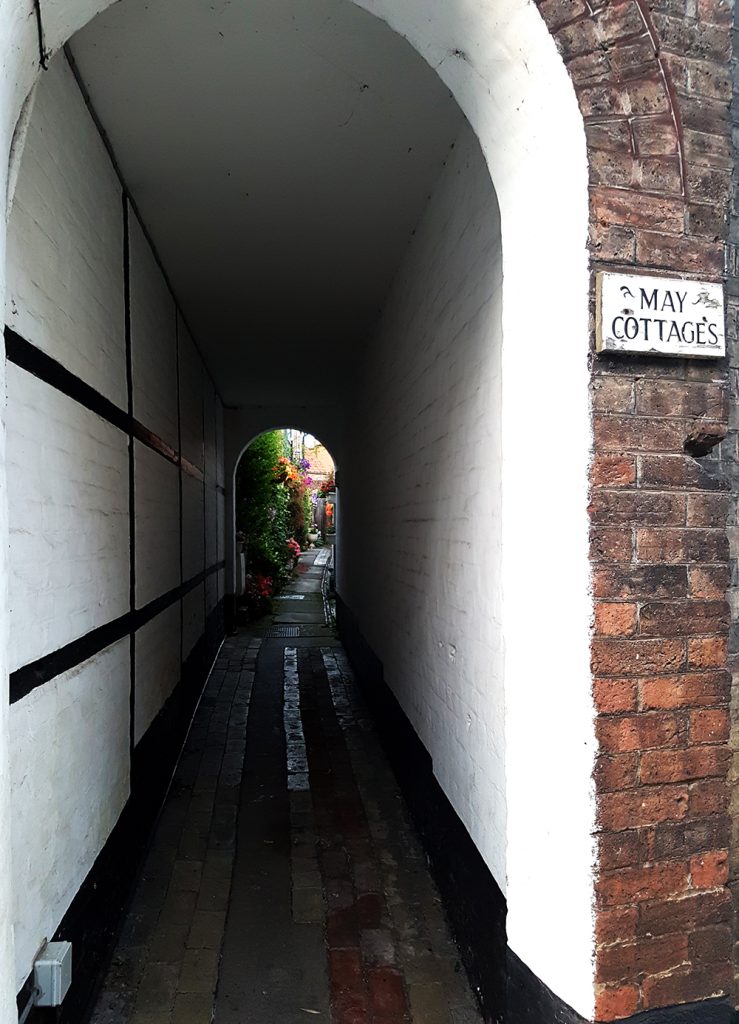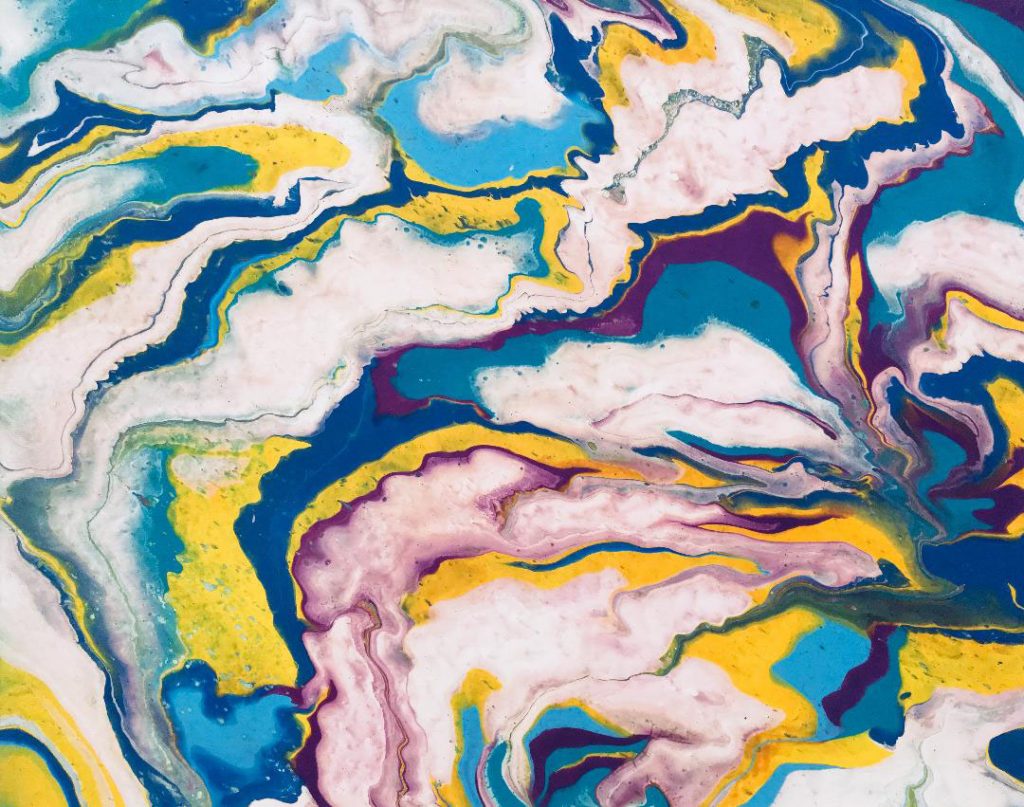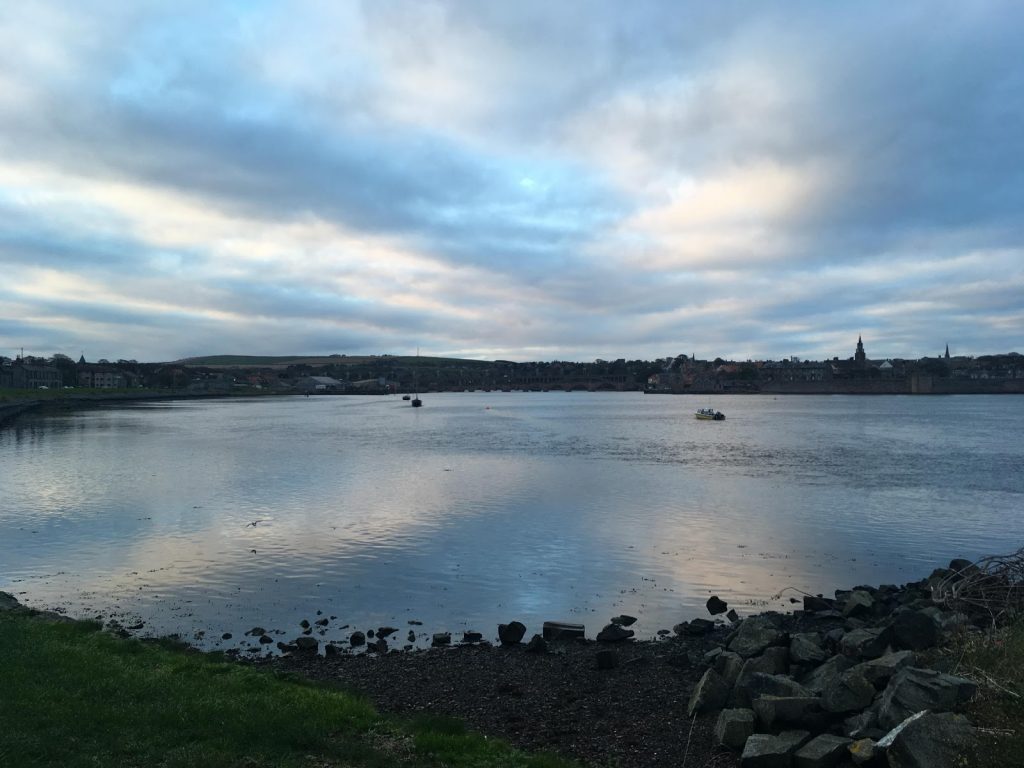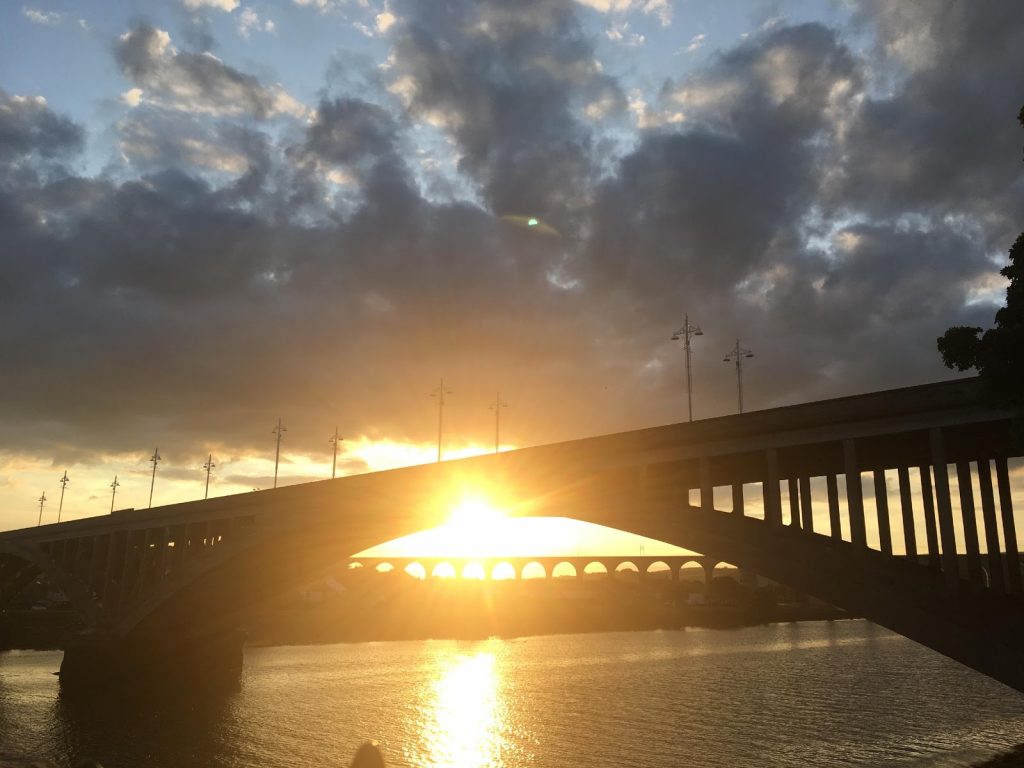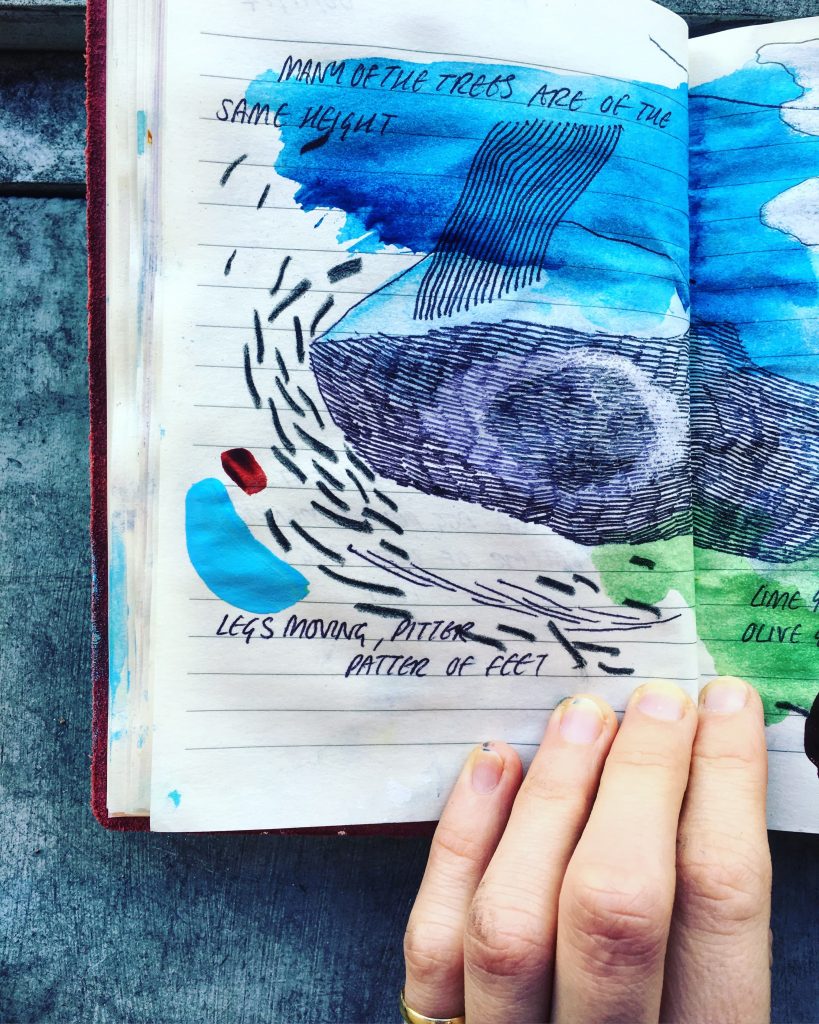Category:
The How Series: It’s a Matter of Experience
August 13th, 2018 by Emma
How do you experience the world?
Let’s use going for a walk as an example. When you’re walking through a woodland area, how do you experience it?
Do you look up and around, allowing yourself to be engrossed by the height of the trees? Are you taking in the colours: the deep earthy browns, fluorescent greens or rusty oranges? Is your nose picking up the scent of woodland air? Are your ears tuning in to the sound of rustling leaves beneath your feet? What about the temperature of the stream; how cold is it?
Or are you just going for a walk?
Not all of us tune into our surroundings in this way. We’re all different and there is no right or wrong way about it.
I tune in as much as I can.
I used to underappreciate the world. I avoided anywhere outside my house and found the mere act of existence to be bleak and taxing. This was grief.
As many of you already know, painting was what flipped life around for me after my Dad passed away. As months of random, expressive painting went on, my need and eagerness to find inspiration grew and grew. Therefore, the outside world became appealing. I’d stare out the window of my studio and my eyes would dart from side to side as I watched the neon red car lights flicker by, again and again. I started to notice the different pitches of car horns, the sound of the weekly runners’ feet pitter pattering on the pavement and the whistling of the wind.
I was tuning in.
This was the inspiration I was longing for.
Sights and sounds became marks and colours.
I found the courage to step outside again and my practice has continued to develop ever since.
My journals are where I document the things I experience: sounds, textures, colours, conversations and thoughts. In doing this, I’ve built a deeper appreciation and more colourful affinity towards nature, society and culture, a.k.a. the world.
The How Series
A fast, corkscrewed mark could be a moment of frustration, the rhythm of the wind or a roughly textured surface; a bold puddle of blue could represent deep feelings of melancholia, a mass of rain or simply, the hue of the sky; repetitive lines could be a meditative exercise, contours of cliffs or a boring conversation; shapes could be sourced from negative spaces, pebbles or rows of trees.
Each work in the series doesn’t necessarily represent one place, at one given time. They’re deconstructions and chosen combinations of colours and marks recorded in my journals.
They represent how I see, how I hear, how I feel and how I understand.
For me, these paintings will act as reference points for future works, like a visual dictionary. For you, perhaps a reminder that there is more than one way to view this world.
Be a How Collector
After the opening night of my first solo show, where I exhibited 20 framed “How” paintings, I’d already sold 18 of them, locally and internationally (still can’t believe it).
It seemed that many gallery visitors were captivated by their presence, with some telling me what they saw in a piece and how it made them feel. It was fascinating listening to the wide variety of interpretations. We all see things so differently; it’s incredible.
In light of the success of this series, I’ve now released 18 more that are available to collect.
(Update: There are now only 7 Hows left all together.)
How #25 Acrylic, spray paint, pencil and soft pastel on paper, 5″x7″, 2018. View work
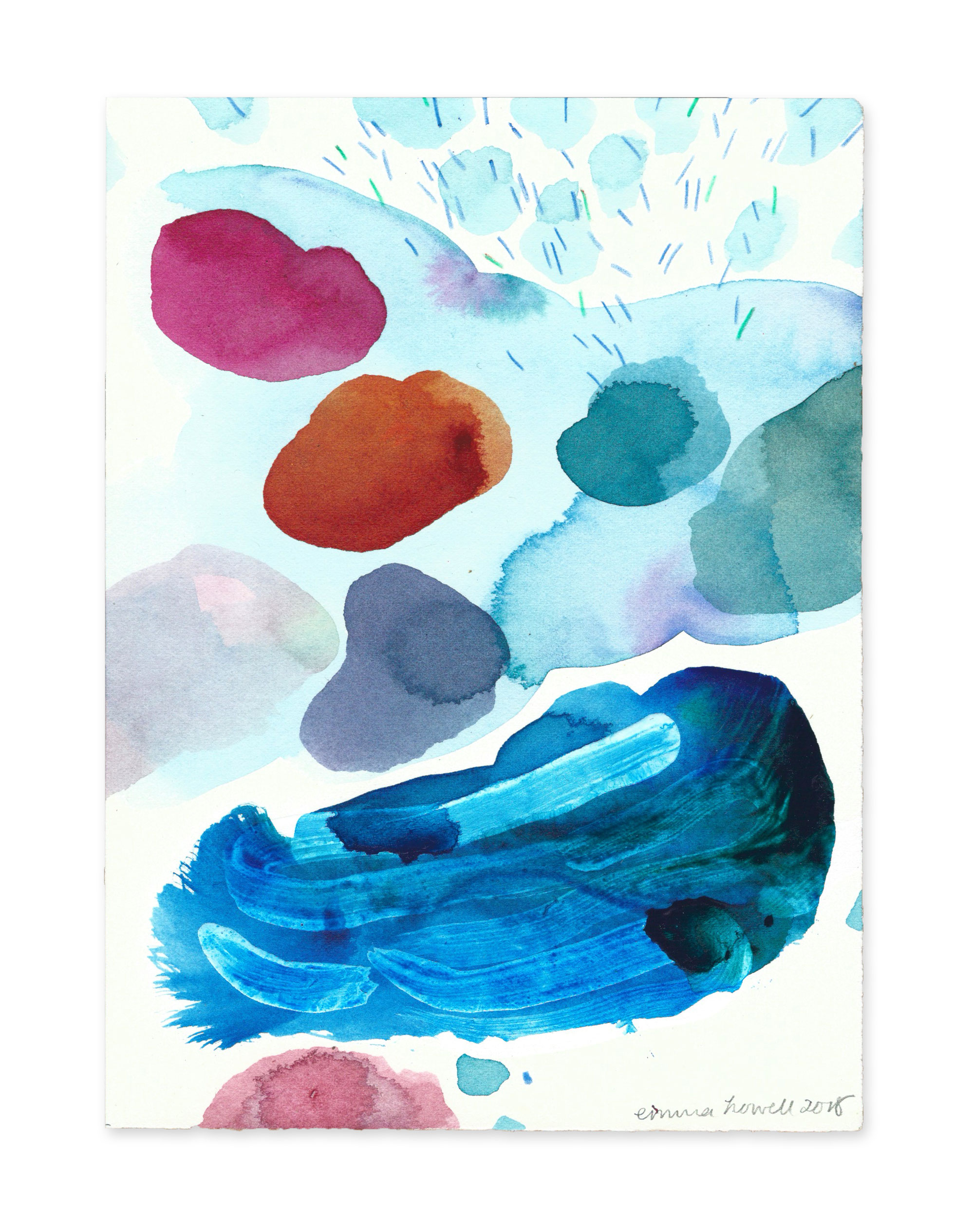
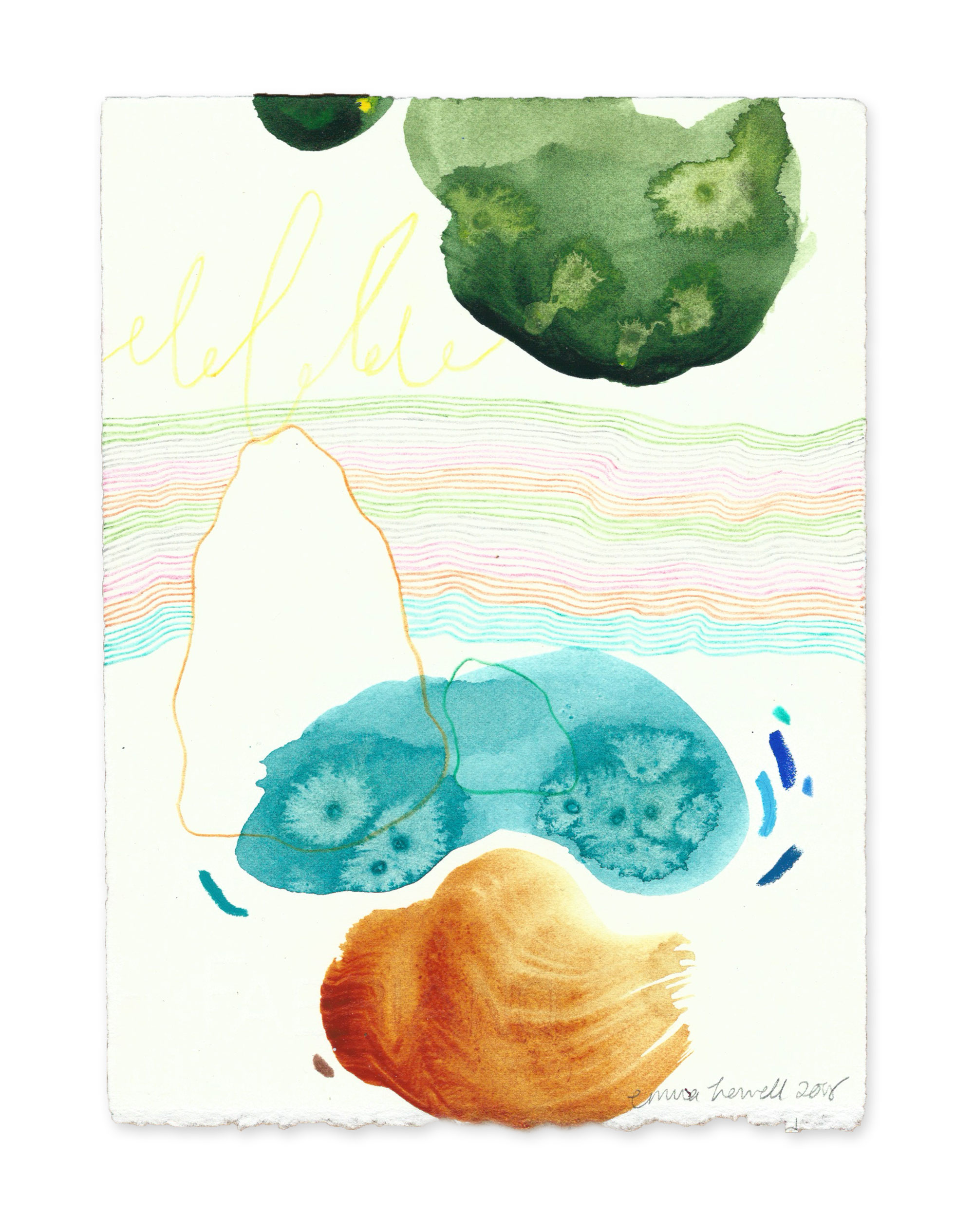
Thank you to all of my collectors. You’re enabling me to continue my practice and I will be forever grateful.
Homegrown: An Honest Retrospect of my First Solo Show
August 6th, 2018 by Emma
Firstly, I’d like to thank Hobbycraft for sponsoring the exhibition. I’m very grateful for the support I’ve had from them over the last few months and it was a delight to meet Gemma and Beth from the HQ at the show! You can read their evaluation of the opening event over on their blog.
The Gallery Space
Homegrown takes place in my studio-come-gallery space above my Dad’s music shop, Aroundabout Sound. For a long time, the 12-foot room was used as a bass showroom and stockroom for the shop. But after my Dad passed away, the stock of instruments was significantly reduced, leaving the space empty, mouldy and lifeless.
Last year, in desperate need of a larger space to paint in (that wasn’t my flat), I moved my art supplies into the upstairs room and started using it as a studio. For about 6 months, I painted in an unwelcoming environment – the walls were lemon yellow, the ceiling black and the carpet grey, stained and mouldy.
When I decided to plan a solo show, and after finding out that local galleries were way too expensive and hard (as an emerging artist) to exhibit in, my family persuaded me to put on my own show in the large space I’d been working in for the last few months. So, with the help of my friends and family, we renovated the entire space from top to toe: re-plastering the walls, painting them white, ripping up the carpets and fixing the light fittings. It took 5 months of blood, sweat and tears – but we did it.
In the near future, my Mum and I are hoping to exhibit the work of other artists in this space. To enquire about this or to show us your work, please get in touch.
The Curation
I want you to feel comfortable and uplifted when you enter the space. The clean white lights, rustic wooden floors, pastel flowers and dark green plants are there to not only bring the space together, but also to make you feel at home. In two different corners of the room, sits a sunburst bass and an ultramarine electric guitar to give the space context, add to the home decor vibe and harmonise with the coloured works on the walls.
Homegrown has been curated in a way for you to walk easily around the space. The larger paintings in the show hang quite low (approx. eye level) and close together, so that you’re given the opportunity to get lost in each work and embark upon your own visual adventure. Then there is a quick and clear path to move onto the next piece.
The curation of the smaller works, The How Series, was inspired by Heather Day’s exhibition last October. These simple and intimate works are to show deconstructions of colour and mark combinations sourced from my journals. For me, they act as reference points for future works and for you, a reminder that there is more than one way to view this world. I find it important that these works are viewed together, as one series – like a visual dictionary.
The deckled edge of each work is exposed in bespoke natural wood frames made by Regency Gallery and Framing – adding to the organic, rustic and homey feel of this new gallery space.
The Music
Having had a musician for a father, music has played a significant role in my upbringing. Consequently, after his death, I found listening to any kind very difficult.
The uplifting and inspiring songs played in the space are the ones I’ve relearnt to listen to and have fuelled my creative process in ways I would never have expected. I wanted visitors to feel comfortable and uplifted whilst they viewed the artwork, so I felt that having background music would add to their journey in the space.
The Opening Night
At various intervals, 107 people in total wandered up the stairs with glasses of Prosecco in their hands. Within the crowd was Stephen Marston (the Vice Chancellor of the University of Gloucestershire), Michelle Fyrne (the co-founder of So Glos), Heather Toward (wonderful artist and illustrator) and several not-so-familiar faces turning out to be lovely social media followers.
22 out of the 30 paintings exhibited have sold already and I can’t thank my new collectors enough for supporting my practice as an artist – it means a lot.
So, the whole night (albeit very overwhelming) was pretty successful – I must say.
The Extra Gallery Space
Something I haven’t talked about yet is the extra gallery space we renovated downstairs in the music shop. Within the last few weeks leading up to the show, we decided to exhibit paintings from my earlier collections (labelled as the “back catalogue”). Putting these paintings on display to the public is exposing my journey as an artist, so far. Hanging on the freshly painted white walls, is an abstract London scene painted in 2014 at university, a variety of expressive and colourful works created when I was in the whirlwind of raw grief and some experimental mixed media canvases.
I was quite reluctant to exhibit these works at first – but many visitors seemed to be fascinated by the development of my practice. Phew!
We are going to be using this downstairs space for workshops in 2019 (e.g. life drawing, still life, abstract painting workshops etc.). To enquire about this, please get in touch.
An Honest Feeling
Despite the wonderful success of the opening night, I have to admit – I struggled.
I struggled talking and being constantly in the limelight. This was well and truly out of my comfort zone. After admitting these feelings to my friends and family, they were all shocked and said I seemed totally confident all night. When – in fact – for most of the night, I just wanted to escape to the bathroom to splash cold water on my face or to have time to myself. I must be pretty good at hiding it.
Having so many people from different walks of life (some I hadn’t seen in a few years) meeting together in the same room, was extremely overwhelming and I found it difficult to juggle so many different conversations. The sweltering heat of the space didn’t help either – the whole night was pretty sweaty, to say the least.
Nonetheless, I feel so very grateful for the support from everyone that made it to the show. At the end of the night, I stood outside across the road and stared up at the gallery window, smiling. Seeing all of these faces together and knowing that they were there to cheer on my career as an artist made me feel very emotional and appreciative.
For all of you who are unable to see the exhibition, here are some more photographs taken on the opening night:
You can browse the remaining paintings that are left on my art page.
Photography by Matt Beard.
Paintings in Cheltenham: An Artist Exploring her Hometown
July 24th, 2018 by Emma
An artist, a photographer and a digital producer wandered the streets and the hills of Cheltenham to photograph new abstract paintings that debut this August.
Located on the edge of the Cotswolds, Cheltenham is a regency town renowned for its horse racing, cultural festivals and areas of outstanding natural beauty. I was born here, in this beautiful place – and I’ll never take for granted.
Many of the new paintings exhibiting in my first solo show, Homegrown, were inspired by Cheltenham and its surrounding areas – so, here are a few fitting in with the townscape.
Pen y Fan, 22″ x 15″, 2018. Queens Hotel.
Pen y Fan, 22″ x 15″, 2018. Cheltenham Promenade.
Listen To Winter #2, 22″ x 15″, 2018. Next to Sophie Ryder‘s The Hare and the Minotaur.
Pen y Fan, 22″ x 15″, 2018. The Beer Gardens.
Listen To Winter #2, 22″ x 15″, 2018. Pitville Pump Rooms.
Never Far From Colour #2, 22″ x 15″, 2018. Cleeve Hill.
Please join me at the opening of my show on Friday 3rd August from 7pm until 10pm above Aroundabout Sound on the lower high street, GL50 3JA.
View all the paintings exhibited.
Follow my practice on Instagram.
Photography by Matt Beard.
Frames by Regency Gallery and Framing.
Paintings by Emma Howell.
Homegrown: A View of my New Paintings
July 20th, 2018 by Emma
In two weeks time, the doors to my first solo show opens.
Homegrown will exhibit 30 paintings to reveal 18 months of healing. Marks and colours sourced from my journals coalesce to form visual adventures.
Join me for the opening night on Friday 3rd August from 7pm until 10pm at Aroundabout Sound in Cheltenham. The work will be on view until Friday 17th August Tuesday to Saturday 10am until 4pm, or by appointment.
You can view and purchase all of the paintings in the exhibition here and send any enquiries to [email protected].
Pen y Fan, 22″ x 15″. View work
What Days Are Looking Like #2, 22″ x 15″. View work
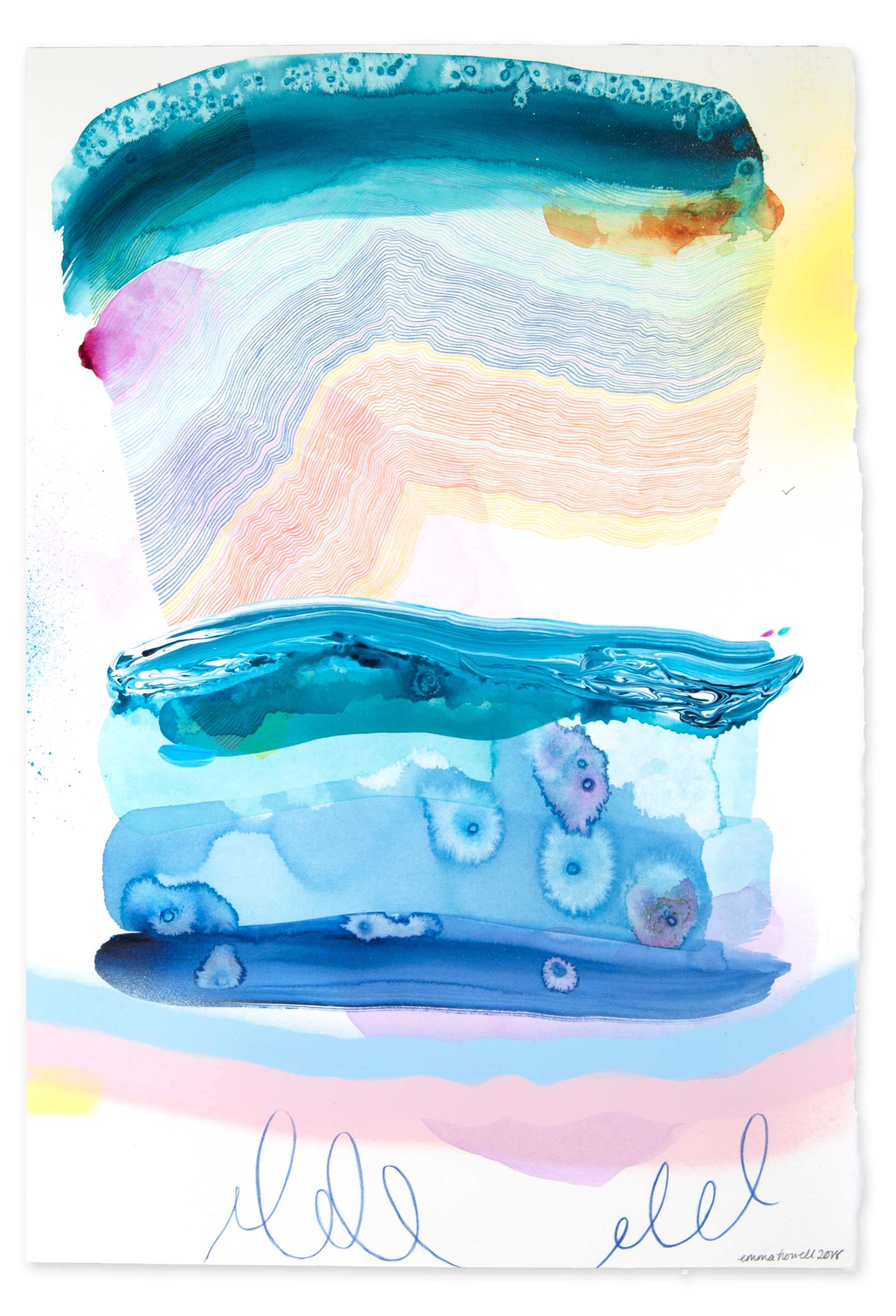
How #7, 5.5″ x 3.75″. View work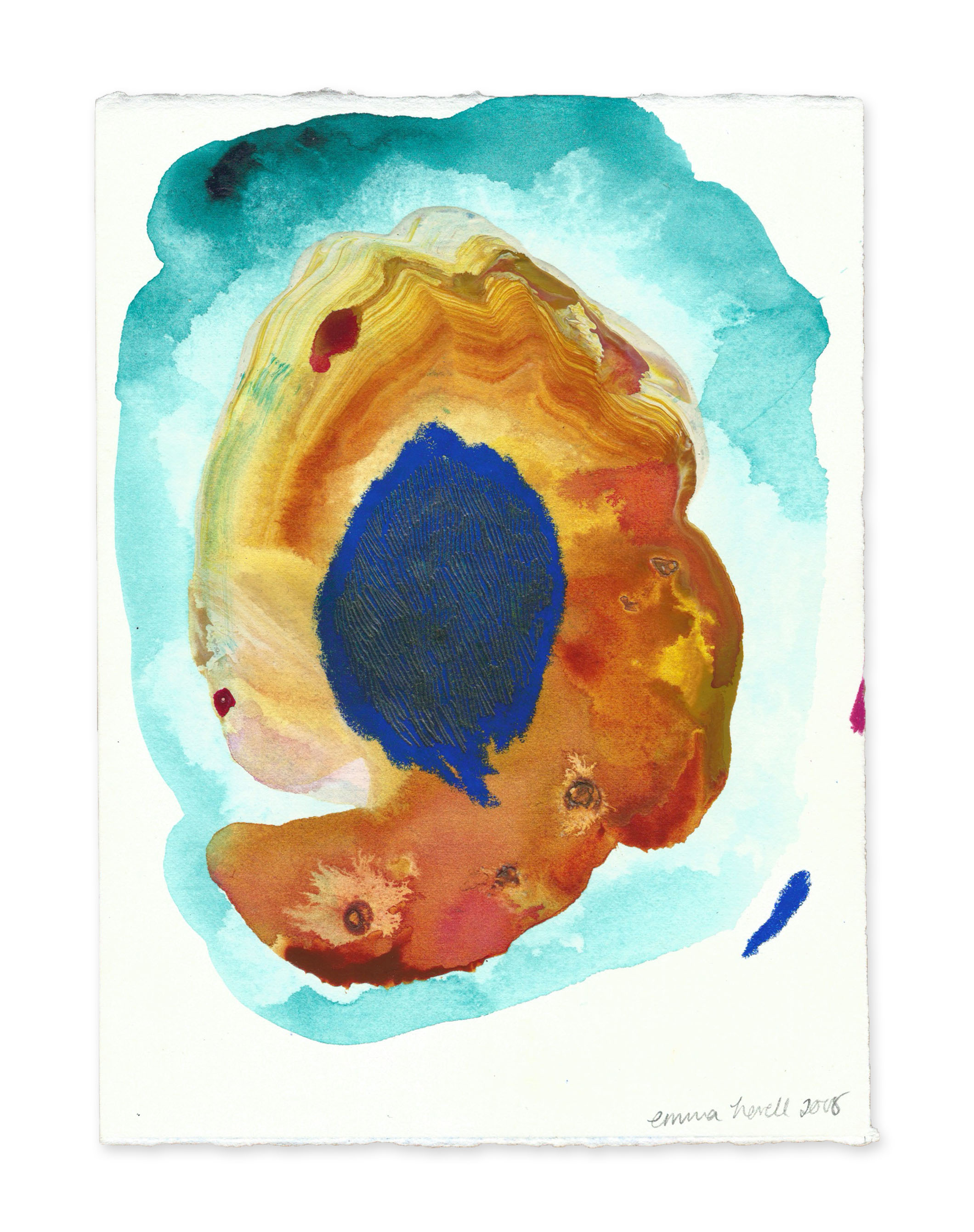
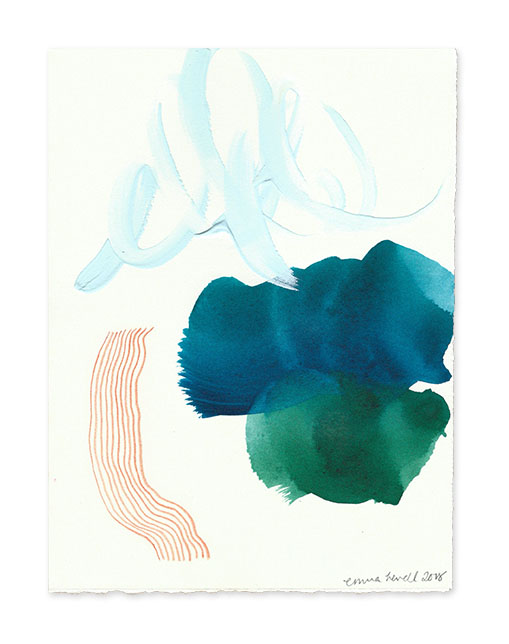
Please note: All purchased works have bespoke frames and will be shipped once the exhibition closes after August 17th. Shipping costs vary depending on the work and its destination, so this cost will be invoiced separately to the online purchase.
What to do after your Fine Art Degree
July 6th, 2018 by Emma
First things first, being a fine artist is hard.
So, if you’ve just graduated in Fine Art, this post will hopefully guide you in the right direction and help you decide what to do after your Fine Art degree.
So, your degree is finally over
You’re feeling really good. All of the work is finally over. Your dissertation is in, your degree show has come to a close and perhaps you’ve even sold an artwork or two as well. It’s a great feeling of accomplishment – I remember it well.
So, what do you want to do now? Perhaps give yourself a break and go on holiday – or swiftly throw your CV out here, there and everywhere to start earning some money in the “real” world. It’s a pretty tough time, despite the celebrations.
My transition from graduating to working as an artist was not smooth, at all. I completed university at the end of 2015 and got back into painting at the beginning of 2017. That’s a pretty big gap.
To be honest – when I graduated, I wanted to escape Fine Art. However, I did make an effort to research potential jobs, like a gallery intern, a school art technician or an artist’s assistant – but found myself feeling nauseous about the whole notion of “The Art World”. It didn’t feel very me (at the time). So, in the two-ish year gap, I bounced from role to role, trying to figure out what I wanted to do. I worked in a clothes store, behind a bar, at a school and in a nutrition centre – but nothing brought me happiness. Unfortunately, I had to suffer a tragedy to realise that working as an artist was, in fact, what I was meant to do from the start.
Looking back, I only wish that I’d found a blog post about what to do after a Fine Art degree – it would have made it a lot easier to make a decision.
So, what should you do now? Keep reading.
Like I said, “The Art World” is pretty intimidating
You’ve got to accept this. The Art World is a huge industry and it’s very competitive, often pretentious and all-in-all a scary place to be. You’ll know from your course that putting your artwork in front of the world is quite frightening – so are you ready to take on the challenge of trying to make money this way?
There are thousands and thousands of artists in the UK trying to make it – and most likely in all the other countries too. The market is overcrowded, but does this mean you shouldn’t bother? Absolutely not.
You can fit into the Art World in whatever way you want to – just don’t expect Charles Saatchi to chase you at the start of your career.
Well.. you never know.
Let’s be frank: you need to get (another) job
You know the whole ‘starving artist’ notion? Well, it’s damn true for the majority of us. We are poor and busy, so we have to sacrifice a lot of things (our social life, holidays, relationships, clothes, stuff..) in order to stick to our plan of being a full time artist – it sucks.
Quality art supplies are also extremely expensive. And when you’re adding this cost to your studio rent, house rent, bills etc. your outgoings are getting pretty hefty.
So, when you’re a recent graduate – unless you’ve made killer connections, have a financial aid or already have an ace reputation – it’s going to be very hard to fund your whole art business on art sales alone.
Don’t put all your eggs in one basket. Go get a regular job – for the time being.
Having another job also gives you more social interaction and an opportunity to step back from your work once in a while. So, try not to feel bogged down by a bar job, office work or making coffee because it’s only temporary.
But what’s it like working for yourself?
Do you like working for someone else? Or do you dream of being self-employed?
I’ll tell you now – working for yourself (particularly as an artist) is risky, terrifying and unpredictable; some people may call you mad, stupid and/or reckless. But do you know what I say to these people?
I say “yeah, you’re right – and look how much freedom I’ve got”.
Freedom.
Working for yourself grants you omission from a crowded office, an intimidating boss and the requirement to wear smart clothes. Working for yourself means that you have no choice but to grow into a strong, independent and business-savvy person – no choice.
Which brings up a slightly negative aspect of self-employment: for someone who isn’t blessed with the gift of mathematics, who lacks organisational skills and a self-esteem (me), it’s very hard to get the hang of taxes, marketing and self-promotion.
You feel out of your comfort zone 24/7.
But isn’t that marvellous?
What better way to learn how to swim than to constantly be in the deep end.
Hold up. What about an MA?
This is a tricky one – and it all depends on you and your lifestyle.
I was urged by my course leader to do an MA in Fine Art. My first thought was absolutely not – can I have a break from education please?
However, last year, the prospect of going back to study art at a higher level (and at a more prestigious art school) seemed rather appealing. I’d followed a few art schools on Instagram, and found myself craving the routine and academic/social aspects of university life. So, whilst I was on the plane home from Greece, I wrote pages upon pages listing the pros and cons of studying an MA.
Here are some points I deduced:
Pros
- Relevant networking/making connections
- High end galleries may favour your CV
- Potential to learn more (first-hand) from academics
- You get a studio space (hopefully)
- Interaction and collaboration with other artists
Cons
- It’s very expensive – do you want to be in more debt?
- It does not guarantee success – by any means. In this day in age, more and more artists with no qualifications are being considered by galleries and businesses.
- It will take up more of your precious time
- You’re location dependent – again
When I returned to Cheltenham, I sat on the floor of my studio and looked around at what I’d already achieved (without an MA) – and at that very moment, I decided to not go through with it.
My student loan is already over £30k and to be honest, I don’t feel like I need an MA. I have faith that I’ll be successful without the letters after my name.
But, please – if you want to go for it, go for it; It will be an incredible experience, regardless!
Finding a studio space
So, if you’ve decided to hold off on the MA for the time being, it’s time to find yourself a place to develop your art practice.
One common notion among local artists I’ve spoken to is that finding a space to create your work can be a very frustrating and expensive ordeal. At the beginning of your art career, your space to work in is likely not going to be glamorous.
Do you have a spare room? Do your parents? Perhaps there’s a local space for emerging artists in your hometown? I’ve seen some artists working in garages and heard about some who rent desks in an office – yes a desk in an office. Unfortunately, at this stage in your career – you need to find wherever you can to do your work.
I don’t advise that you use your living room or bedroom – this is what I did for the first 6 months. I found it claustrophobic and felt as though I couldn’t take a step back from my work; I was constantly immersed in it, which isn’t always good.
As an example, imagine being stuck in a room with one person – day in day out. You do like that person, but there are moments where you just need to walk away for some air, some space, some perspective.
Having your artwork spread out in front of you, alongside all of the paints, brushes and materials can also get pretty cluttered – so, not ideal for a living space. You’ve also got to be respectful towards your housemate, if you have one. Sorry for the messes I used to make, Jon.
My studio situation is both unfortunate and fortunate. At the beginning of 2017, I moved into my studio (and now gallery space), which sits above my Dad’s music shop. It’s quite a large room with a 12ft ceiling, old wooden floors, plenty of wall space and a large window that looks out to Cheltenham’s busy lower high street. In a lot of ways, this space could be considered an artist’s ideal studio space – and I’m very grateful for that.
However, the only reason I’ve moved there is because the room was cleared out after my Dad passed away in 2016. It used to be a stockroom and bass showroom for the music shop – but since my Mum took the reigns, she’s cut down the amount of stock in the building. Thus, leaving a lovely room – steeped in history – empty. And that’s why I moved in.
As American author Rick Riordan says, “out of every tragedy, comes new strength” and losing my Dad was where I found the strength to pursue a career as an artist.
Back to you – is your work crap?
Yes, you’ve completed a 3 maybe 4 year degree in art and you may be totally confident with your current style. But have a look around, what is the art world looking like. Be smart with yourself – are you making crap art?
If you intend to sell your work, you not only need to be really confident about it, but also you need to be realistic about a target market. Is there a particular market you want to sell to? Do you want to have gallery representation? Where do you want your work to hang – in hotels, in coffee shops, in people’s houses? Being focused on your work goals makes business a lot easier.
Of course – you are entitled to make whatever art you want to (I certainly do) and you could be just as successful as someone who’s planned it all out. But in this ever-expanding community of artists, does your work stand out – and is it good enough?
To figure this out, it’s important to know yourself and your work. So, grab a notebook and jot it all out.
Many, many times I’ve written down (and answered) these questions:
Why are you an artist?
What are you trying to show/prove?
Why is your work important?
Why should someone care about/collect your work?
Why do you use these particular materials?
Answering these questions keeps your head (mostly) clear, enables you to set goals and then learn how to reach them. If you have a scatterbrain like me (apparently quite common among creatives), you’ll need to regularly tune in with yourself. If you keep asking yourself why and how, I’ve found that it prevents those ‘what am I doing with my life!?’ and ‘my work is a load of crap’ moments.
Keep a level head and be realistic with yourself.
OK – and how do you make money as an emerging artist?
At present day, artists are being given more and more opportunities to make money – and not just by selling artwork. This is obviously the numero uno goal – make work, exhibit work, sell work, repeat. However, if you contact/are spotted by the right people/brands – and provided the collaboration would be ethically sound – you’re able to earn money through sponsored posts and targeted marketing campaigns.
Be smart and savvy with your art business. What are your skills other than creating artwork? Could you also teach and provide online content, like video tutorials and ebooks?
.. and that’s just the digital world.
What about the real world? Where you can host local workshops, set up market stalls and talk to real people about who you are and why what you do is important. Make friends. Make connections. Make business. Make money. (More on this in the next section)
So, how do you get ‘known’ or ‘spotted’?
This is tricky and it varies from person to person.
To get spotted, you need to put yourself out there – locally, regionally, nationally and internationally (usually in that order). Aside from social media, you need to network with the right people, in person.
‘To get spotted’ is actually something you shouldn’t rely on. From my experience, the best thing for you to do as an emerging artist is to ask for opportunities, and don’t wait for people to come to you because 9 times out of 10, they won’t – sorry for the bad news.
Ask for advice from other artists.
Ask a business if they’d like to see your work.
Ask a brand if they’d be willing to collaborate.
Ask an influencer on social media to share your work with their audience.
Ask your audience what they think of your latest piece.
It may take 100 asks to get 1 yes, but this is a lot more productive than waiting for people to find you.
But make sure you’re super confident in what you’ve created before you go out and ask – otherwise you won’t be confident to ask people. Once you’ve grown your confidence, find people and tell them who you are and why they need your work in their life.
In addition to this, an online audience is extremely helpful for exposure. Yes, I’m talking about Instagram followers, Facebook fans etc. It’s apparently meant to be the time for artists to get on the Instagram train. It’s very quickly zooming by, so throw yourself on – if you can.
Regularly publishing your artwork on social media (Instagram, Facebook, Twitter, Pinterest etc.) is a way to get more eyes on your work – and this is what you need. More eyes.
More eyes = more opportunities.
There are over 800 million active monthly users on Instagram. So, if you manage to ace the right kind of strategy, there is a lot of potential to grow your business here. It might be worth setting up a Facebook business page too.
You’ll be able to read how to promote your art on Instagram soon on my blog.
Hey – what about artist residencies?
An artist residency is a great option for young artists and recent graduates.
But what exactly is an artist residency?
They are programmes that give artists the opportunity to stay and make art in a place that is outside their typical working environment, away from their usual hustle and bustle. They give you the chance to develop your practice in a new location, potentially with new materials and quite often, among other creatives (and mentors). Bear in mind that many residency programmes come at a cost – and quite a hefty one at that. Conversely, there are paid opportunities too – you’ve just got to find the right one for you. Whether it be at your old school, in your capital city or on the other side of the globe in Bali, there are thousands of places you can dwell and develop your practice.
Residencies look pretty good on your CV too, so perhaps consider applying for a few when you’re ready.
Artsy have a great guide on how to go about artist residencies.
Get a website and start a blog
Seriously – do this now.
You need to get writing about your work, your influences, your inspirations – anything. You need an online presence that isn’t owned by a third party, like Instagram. Imagine if they got hacked or stopped completely, like Vine did (I loved Vine – anyone else?!).
You need to own your own online space where you can market yourself. Save up and pay for a website, or sign up to a free blogging platform. Do what you can to obtain a place to direct people, so that they can learn more about your work.
As well as being an artist, I also work in an SEO agency to help fund my practice. Here, I’ve learned a lot about the importance of a website for a business – especially in this day in age.
Write often and write well. You want people to find you – and Google love regular and unique content. No copy and pasting – you’ll get found out and it penalises your ranking on Google.
Once you’ve set up your website/blog, you’ve given yourself a huge marketing opportunity. And now, all you need to work out is how to get people to your website. Again, a very difficult task.
In addition to this, you could also consider setting up an online shop on platforms like Etsy or Shopify. You want to sell artwork – right? So, this is a great way to get started. But bear in mind that you won’t get many sales without a marketing strategy – yes, that word again. So, try and not waste your time..
To be able to market yourself, you’ve got to believe in yourself
Remember what I said earlier about confidence, marketing and self-promotion?
Well, to succeed as an artist, you must be able to talk about yourself and your work – confidently and regularly. If you don’t believe in your work, your talents – yourself – you cannot expect anyone else to believe in you. There’s a quote somewhere for this..
Most of us are self-critical and our own worst enemies when it comes to career/life goals. You know, that voice in your head that’s like “you can’t do this”, “your artwork sucks”, “you’re so out of your depth” and “this will take you years – don’t bother”. If you’ve ever said any of these to yourself, you need to go back to square one and ask yourself those questions I asked earlier.
When it’s time to start marketing yourself as an artist, you’ve got to make sure that you’re ready to talk about your work confidently and also, be open to criticism. Yes, there will be people out there that will hate your artwork. But that’s fine – because this means that there are people out there that will love your artwork.
Land your first “real world” exhibition
Set this as a goal and work towards it.
You may feel that this is well out of your reach right now – and hey, it probably is. But for you to make it in this world as an artist, people need to see your work. So, to begin with – go local. Ask local coffee shops, restaurants, offices, even art galleries how they’d feel about exhibiting your work. Tell them that you’re an emerging artist and looking for opportunities to increase your visibility. You’ll get a handful of no’s but remember what I said earlier, it may take 100 asks to get 1 yes.
Get the ball rolling. Once your work hangs in one place, it will start a chain reaction and create more opportunities (e.g. commissions, artwork sales and further exhibitions).
Generate local buzz, tell the press your story and promote the hell out of your work. Share it online and ask your friends, family and colleagues to spread the word. After a while, people will start talking about you and BAM you’ve got local exposure.
After you’ve had your first exhibition, whack it on your CV and then repeat the process. Perhaps go a little bigger next time and approach galleries/businesses in a neighbouring city.
Over time, your reputation will grow. But remember – this will all take time, so be thankful for your other part-time job at this point.
It’s all about the long game.
What to do after your Fine Art degree checklist
- Take a break but don’t lose momentum
- Decide whether or not to do an MA
- Get a part-time job (seriously)
- Find a space to work
- Develop your practice and be honest with yourself
- Consider an artist residency
- Introduce yourself online (social media and your website)
- Introduce yourself offline (talk to real people and attend events)
- Ask for opportunities
- Write regular essays/blog posts on your practice
- Develop and ace your marketing strategy
- Land your first show
- Network, network, network
- Repeat
So, do you still want to be an artist?
You’ve done so well to get where you are now; you should be proud of yourself.
Now, are you ready to climb the first rung of the ladder to be a full time artist?
Or is it all a bit too risky?
Up to you.
If you’d like to talk to me about this post, please do get in touch and I will respond as soon as I can.
Homegrown: Introducing My First Solo Show
June 22nd, 2018 by Emma
Firstly, a Thank You
I’m writing this with a smile.
When I was a child, my Dad and I would take frequent trips to Hobbycraft to top up my ever-expanding stockpile of paint brushes, watercolours, sketchbooks, stencils, candle-making kits, anything – you name it. I’d scavenge the shelves and get increasingly excited as I began conjuring up yet another arty project. Dad would be very tolerant of my Hobbycraft addiction – so much so, he’d feed it with hope of me staying creative, and happy.
If you would have told me 15 years ago that I was going to be collaborating with Hobbycraft for my first solo art exhibition, there’s no way I would have believed you. Their innovative and enthusiastic team have been ever so supportive over the last few months, and I will be forever grateful to them; not to mention, their array of high quality products that I still use on a regular basis.
Thank you for making this happen, Hobbycraft.
Introducing Homegrown
How do you perceive the world around you? What colours catch your eye? What sounds do your ears tune in to? Is a view simply a view – or is it an experience that stimulates your mind and senses?
When I fell into a hole of grief and depression after my Dad passed away, I didn’t care for any view. The world was a dark and tiresome place to live, and nothing felt, looked or sounded interesting. As a social recluse and hypochondriac, I struggled with the basic everyday, and my sense of ‘home’ felt broken; rock bottom had well and truly been hit.
Getting back into painting was the first step I made in the start of my healing process. With inspiration from old explorer books and other artists (past and present), a variety of styles and techniques have unfolded in my studio. As my courage and confidence grew with painting, so did my ability to step foot outside the house and explore the world again – and this time, it wasn’t taken for granted.
The more I’ve explored outside, the more my work has evolved. I’ve embarked upon adventures close to home – and with this, my glossary of marks and colours has expanded. Journals are used to document my findings – thoughts are written down, sounds are translated into marks, and colour combinations are swiftly mixed and archived.
The work in Homegrown is the harvest of these eighteen months of seeking and healing. It’s evidence of the new relationship I’ve built with life and everything it has to offer: weather, colour, sound, conversation, adventure and opportunity.
Within the works, a quick corkscrewed mark could be a sharp and chilling breeze or a sudden rush of enthusiasm. A block of colour is to catch your attention, evoke mood or to contextualise a location – perhaps land, sea or sky. Repetitive lines act as a meditative process, feelings of monotony or the structure of a setting – like the flow of a river, rows of shrubbery or the contours of rock.

Homegrown is an exhibition of painted adventures, revealing my significant shift in perception.
Let me take you on a visual adventure and show you where I’ve explored.
Please join me for the opening of Homegrown on Friday 3rd August from 7pm at Aroundabout Sound in Cheltenham, my hometown. RSVP.
Limited Edition Giclée Fine Art prints of pages from my journals are available at my shop.
Julia Cusworth: How Do You Adventure?
March 7th, 2018 by Emma
BIO
Hi! I’m Julia, an artist and designer living in the North of England; currently exploring my love of colour and pattern through abstract, mixed media work. I wish for all my pieces to brighten lives and bring joy!
Instagram handle: @juliacusworth
Website: http://www.juliacusworth.com/
Etsy Shop: https://www.etsy.com/uk/shop/JuliaCusworth?ref=l2-shopheader-name
Where is your home country?
Home for me is Norfolk, England
What is the name of your hometown?
I am from a small town called King’s Lynn
What are 3 words that describe your hometown?
Rural, enclosed and green.
Why is King’s Lynn fricking awesome?
I left my hometown when I was 19 but go back often to visit my friends and family. When I hear the Norfolk accent it’s like a warm cup of tea. When I see the flat countryside fields rolling out alongside the road, it has a familiarity that feels so right. I have never lived in my hometown as an adult so it is childhood nostalgia and hometime joy to me.
Where is the first place you go when you’re bored?
The seaside! Living 15 minutes away from some of the most beautiful, secluded beaches is a thing I miss constantly.
Where do you go to find natural beauty?
For a walk; a countryside walk in Norfolk means seeing for miles and miles and watching the sun set into the ground.
Where would you go for tranquillity and relaxation?
This is very bespoke, but to my grandparents garden. A jungle of flowers, fruits and trees that have grown and been loved for years. Again, it’s the nostalgia and familiarity of it all that means home to me.
How do you make the most out of where you are?
I try and squeeze in as much as I can when I visit home. At least one trip to the seaside, one walk through a field and countless hours driving down tiny, rural roads.
What are the top 3 things a visitor needs to do/go see in your hometown?
- Visit Holt or Holme, my favourite beaches
- Take a day trip to Norwich. Full of colour, creatives and old architecture (always the place I wish i lived when I was young!)
- Explore country lanes, extra points if you can find someone selling home grown fruits and vegetables
Where do you go for seriously good food?
My favourite place is a very traditional pub called The Hare Arms in Stow Bardolph. It has a pub cat, peacocks and amazing homemade comfort food
Huge thank you to Julia this. If you’d like to be featured with your hometown in my ‘How Do You Adventure?” series, please get in touch.
Beth Garner: How Do You Adventure?
February 19th, 2018 by Emma
Bio
A self-taught artist, I dived into the world of art after a difficult time in my personal life and began experiments in fluid painting; mixing various cocktails of house paint, gloss, acrylic, pva glue, water and washing-up liquid (anything goes!) Therapeutic and addictive, I’ve probably watched hundreds of art videos on YouTube and have found the Instagram community so uplifting and inspiring. I don’t believe there is ‘bad’ art and anyone can (and should) make art for whatever reason. After living in France, Germany and other parts of the UK for work and study, I have returned to the place I grew up, Berwick-upon-Tweed, with a new appreciation of this area. The ever-changing Northumberland skies and the oddities of light have inspired my abstract landscapes which explore and challenge light, colour, gesture and texture.
Instagram handle: @abstract.beth
Where is your home country?
England
What is the name of your hometown?
Berwick-upon-Tweed (in Northumberland)
How would you describe your hometown in 3 words?
Underrated. Peaceful. Home.
Why is Berwick-upon-Tweed fricking awesome?
I may be biased, but travelling by train from Newcastle on the east coast and arriving into Berwick is one of the most beautiful sights in the world. There are three bridges with their own stories to tell and a light that dances beautifully along the river and out to sea (commuters at sunrise and sunset can attest to this!)
Berwick-upon-Tweed may be small but packs quite a punch. Although the town changed hands between England and Scotland more than a dozen times, we finally settled in England in 1482 but our football team, Berwick Rangers, play in the Scottish League Two. There’s around 25,000 people living in the town and its surrounding area but with less than an hour by train from Edinburgh to the north and Newcastle in the south, we can enjoy the buzz of city life whenever we want.
Where is the first place you go when you’re bored?
A walk along the beach cures everything.
Where do you go to find natural beauty?
As above, the beach really does have it all and no two days are the same. The tide can be wild and ferocious one day then still and inviting the next. I often visit Paris and it is really humbling to come home to a vast horizon and the peace it brings.
Where would you go for tranquillity and relaxation?
Northumberland is one of the least densely populated counties in England meaning that you can go for a walk on Goswick beach or in the Cheviot hills and feel like you’re the only person in the world. If you do meet any locals though, we’re a friendly bunch! If you want to go a step further and literally be cut off, travel to Lindisfarne (Holy Island) which is attached to the mainland by the causeway – just be mindful of the crossing times!
How do you make the most out of where you are?
I try to go for a walk every day which admittedly can be hard when it is rainy and dark in the middle of winter. I have taken some pretty amazing summer sunrise photos which provide fantastic painting inspiration.
What are the top 3 things a visitor needs to do/go see in your hometown?
- Buy fish and chips (my favourite!) and walk along the Elizabethan town walls and pier – waving to seals is optional and if you’re lucky, you might catch a glimpse of the dolphins and porpoises in the warmer months.
- Visit during one of our festivals; take your pick from the Lindisfarne music festival, food and beer or film, media and arts which excellently showcase local talent, often in venues steeped in culture and history. Or just pop in to the Gymnasium Gallery or the barracks to see the latest exhibition.
- Enjoy some live music downstairs at The Barrels Alehouse and learn some local slang.
Where do you go for seriously good food?
The Maltings café has brilliant views over the rooftops and serves food all day. Newly-opened Mule on Rouge is a vegan-curious café and music shop on Bridge Street which has several restaurants serving locally-sourced dishes. Venture a little further afield to the Chain Bridge Honey Farm and have your afternoon tea and cake on an old double decker bus.
Huge thank you to Beth for this. If you’d like to be featured with your hometown in my ‘How Do You Adventure?” series, please get in touch.
The Recap: Redefining an Adventure
January 18th, 2018 by Emma
Happy New Year, Everybody! – I know, it’s a bit late into January to be saying that.. but oh well.
It’s now 2018, and I’m super excited to be writing again.
Let’s Recap
At the beginning of last year, I bit the bullet and decided to get back into painting as a way to deal with the loss of my Dad. Translating my emotions onto paper and canvas enabled me to get back in touch with reality; it genuinely made me feel a lot happier. So, I continued to paint a variety of abstract art collections and also maintained this blog, writing about life as an artist and ways to maintain a happy mind.
September came around and it had been a whole year since my Dad had passed away. And I’ll admit it, I fell into a hole of unhappiness again. Painting just wasn’t working any longer. I felt trapped in my studio and my creativity came to a halt. For most of the year, I was promoting happy art for a happy mind on my Instagram because I was happy and it was (mostly) because of the art I had been making. However, I put too many eggs in one basket. The day came when I tidied up my studio and gave myself freedom. I let myself back outside, where there’s fresh air, engaging sounds and you know, people.
A family holiday to Crete was the game changer for me. I wanted to press the reset button and that’s exactly what I did.
Blank notebooks, pens, pencils, pastels, paints, jars and brushes filled my suitcase. I didn’t want to force myself to be creative whilst I was away. I brought my supplies with me just in case I felt the urge to paint or if I found inspiration. I’d had various project ideas planned for whilst I was away, and I did carry them out- but unfortunately, I didn’t feel connected to what I was creating.
What I did end up connecting with were my blank notebooks, which became very not blank by the end of the holiday. On the plane home, I was doing my usual multi-tasking (I get it from my Mum) by reading Helen Frankenthaler essays at the same time as flicking through the notebooks I’d been painting and writing in. For the duration of the trip, I’d taken these notebooks around with me everywhere, writing down conversations, describing landscapes, making marks and colours to sounds and textures- I’d been documenting everything, creatively.
The books made sense to me. It was like I’d written my own dictionary of experiences. The pages were filled with my interpretations of the way I saw things, heard things and felt things. I had come up with my own language of adventure and experience, and I’m the only person who’d understand it. These books felt very special and quite different to the usual sketchbooks I’d use at home.
Once I returned, I dug deeper into this new process and continued to use notebooks to document life. By doing so, it motivated me to interact with the outside world more. My studio remained vacant but my car’s mileage was ticking as I drove places to interpret and translate into (even more) notebooks, which I now call my adventure journals.
I felt adventurous – driving to places on my own, allowing myself to get lost in the countryside, hauling my art supplies around and truly making the most out of the environment I was in. This may seem like a breeze to some, but for a long time, if you’ve read my story before, you’ll know that I couldn’t interact with the world. So, this was a big deal for me.
My reset button had most definitely been pressed.
Present Day
What do you consider an adventure?
I redefined what the word meant to me:
Whether it be long or short, near or afar, an adventure is a physical and mental process of looking, seeking, finding and collecting. When you go on an adventure, you’re capturing moments, making minutes count and living life to the fullest.
And this is what I do.
I explore my mind and my surroundings to make artwork that tells stories. Wherever I go, I take a journal with me to interpret, record and comprehend the environment I’m in. I make marks from sounds, blend colours from landscapes, put into words the textures beneath my feet and write down overheard conversations. I’ve discovered that creating art is my preferred method of communicating how I see, hear and feel. In doing so, I want to demonstrate to people that embarking on an adventure and feeling the bark of a tree is not only a physical process, but also a mental one.
This year kicked off with a collaboration with Hobbycraft. Have you read it yet?
Here’s to 2018. It’s going to get adventurous.
See what I get up to on Instagram.

